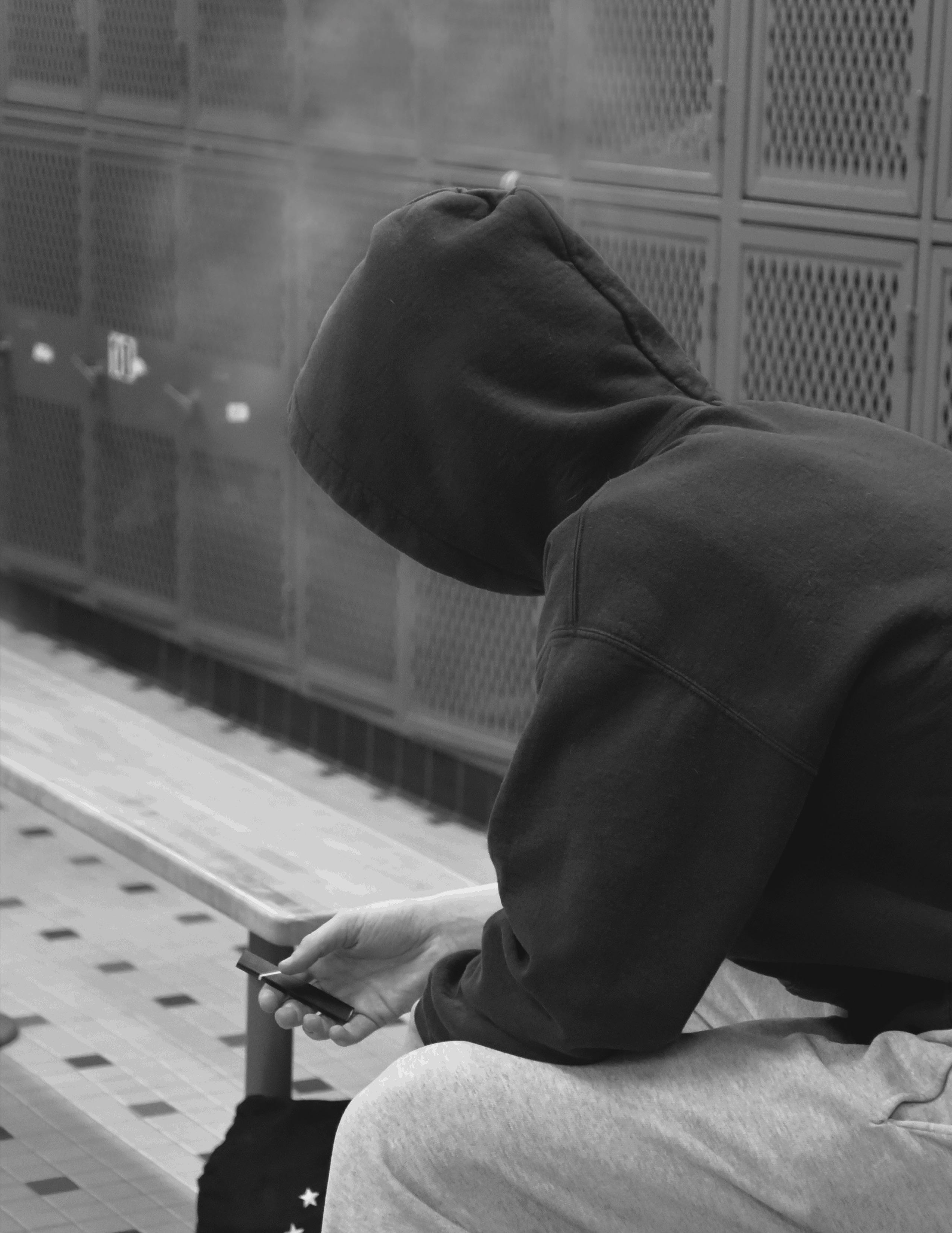
 Mouth of The River
Publication of Oyster River High School
Mouth of The River
Publication of Oyster River High School


 Mouth of The River
Publication of Oyster River High School
Mouth of The River
Publication of Oyster River High School


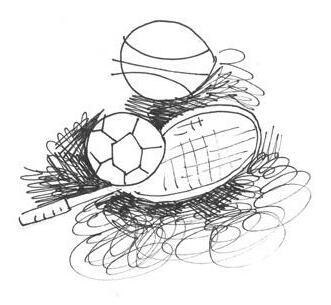
Meet the Staff pg. 1 World Language pg. 3 Insulin pg. 6 Flex pg.8
Sweets pg. 10 Gap Years pg. 12 Addicted pg. 14
GPA pg. 16 Gratitude pg. 18 Parking pg. 20 Junior Year pg. 21
Renner pg. 23 Groutfit pg. 25 Freshman pg. 26
Dear Reader,
We are excited to share with you the first issue of Mouth of the River of the new decade! We hope to start off with a magazine that upholds the high standards we’ve set for ourselves and worked to maintain over our many years as a publi cation.
We pride ourselves on covering a variety of stories that address issues from a collection of diverse perspectives; this issue was no exception. Our stories range from a profile on Sweetened Memories: a bakery that recently opened its doors in downtown Durham, to a news piece on insulin pricing.
Our cover story this issue is Addicted, a features style story highlighting nicotine addiction of high school students. The story discusses both the struggles that students experience when battling nicotine addiction and the school’s approach to the issue.
As always you can find a collection of old and current stories, including coverage of current school and community events and our multimedia stories, at our website, mor.news. You can also find us on Instagram and Twitter for continu ous updates.

Mouth of the River has been lucky to have the support of many businesses in the Oyster River community and looks for continued support. If you wish to become a sponsor or a subscriber of MOR and receive the next issue directly to your door, please email us at mouthoftherivermagazine@gmail.com.
Regardless of whether you’re a sponsor, subscriber, student, teacher, or community member, we appreciate the support that you show our publication simply by reading it. So, thank you, we hope you find that it’s as enjoyable to read as it was for us to make.
Until next time, Joe Morrel and Susanna Serrano, Co-Editors in Chief



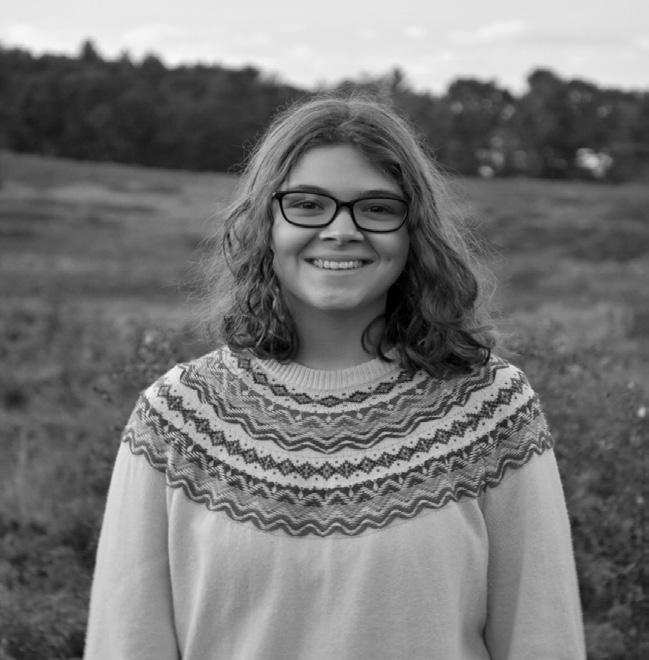

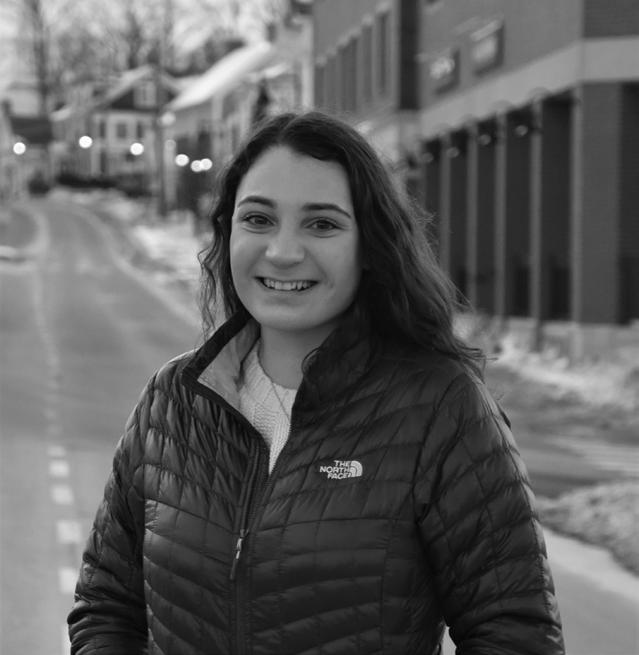
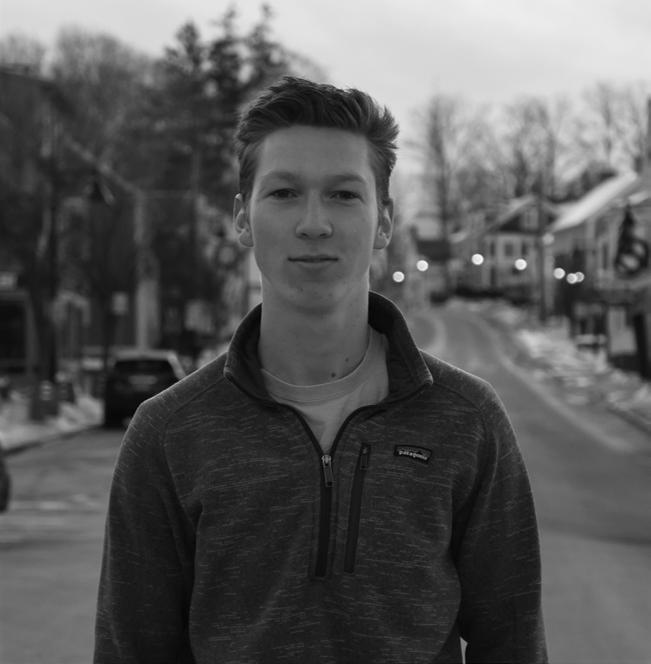

Mouth of the River seeks to reliably inform the student body, as well as the surrounding community, of interesting and newsworthy content in a modern, compelling format. Our goal as a staff is to give voice to the students of Oyster River, and have it heard by all our students. The opinions expressed in Mouth of the River represent those of the writers and staff.




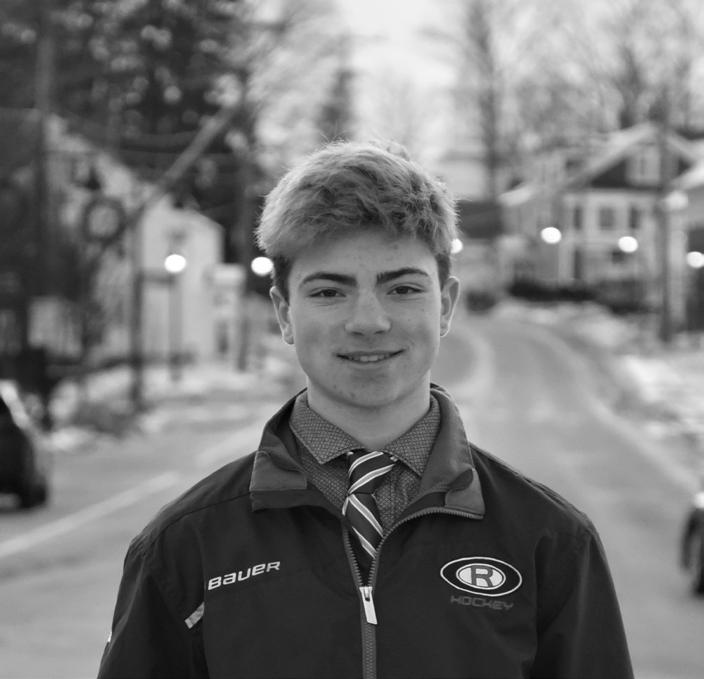





At a time when the Oyster River Cooperative School District (ORCSD) is reexamining several facets of education, including the effectiveness of the traditional grading system and the role of technology in education, the world language department is exempli fying the reexamination mentality by implementing a series of changes to the way they teach world language.
At the root of these changes was the transition from the traditional model to the proficiency model, which was implemented three years ago. Following this change, the Oyster River Middle School (ORMS) and Oyster River High School (ORHS) world language departments adjusted the curriculum so that students who had taken a world language in seventh and eighth grade could move on to level three of their language in high school, given that they were ready, rather than taking level two when they start high school as past students had. These students, including Denise Nadig (‘23) and Justin Partis (‘23), are now in language classes with sophomores and juniors. Two years ago, when Nadig and Partis were in seventh grade, ORMS also decided to begin offering world language in sixth grade, rather than in seventh grade as they had in the past.

Proficiencies are a series of goals, similar to competencies, students aim to achieve as they work their way through the lev els. At the beginning of level one, all students are in the novice low range, as they achieve the proficiencies, they move up, hope fully ending level one in the novice high range. This means that each level has proficiencies students aim to achieve by the end of it, rather than a list of topics or textbook chapters that need to be covered, as the traditional model had.

The world language departments use the proficiencies created by the American Council on the Teaching of Foreign Languages (ACTFL) to inform their curriculums, according to Michelle Pennelli, a world language teacher at the middle school. The proficiencies are expressed through a series of “can do” statements, which explain what a student should be able to do with the language in various topics at each benchmark.
For example, the benchmark for a novice low student when looking at informational texts is, “I can identify memorized or familiar words when they are supported by gestures or visuals in informational texts.” The benchmark for a novice high student is, “I can identify the topic and some isolated facts from simple sentences in informational texts.” Both of these statements are from the ACTFL list of proficiency benchmarks, which explains the expectations for students at the novice low, mid, and high benchmarks in presentational speaking.
Pennelli explained the switch from the traditional model to the proficiency model. “Year one would be moving up to the nov ice high proficiency level. Whereas for us before, when we were in the traditional model, year one was separated by textbook chapters.”
Todd Allen, the assistant superintendent and a member of the world language committee, said, “the advantage to proficien cy is that the focus is on mastering the target language. In the traditional model, which is what we’ve always had in our district, there certainly are kids who reach a level of mastery or fluency [...] but for the most part, not a lot of our students reach that level.”
Barb Milliken, a French teacher at the high school, said, “when you’re teaching a proficiency way of teaching, the focus is on communication and elaboration.” She said that the purpose of the “can do” statements is to clarify the learning target for each lesson, describe what the student can do with the language, and clarify the next step for students to take with the language.
Partis, one of the aforementioned freshmen in level three,
said he noticed a clear difference between proficiencies at the middle and high schools. “We don’t really talk about it unless it’s for a grading rubric, but everything we do is kind of based around it. In middle school, literally everything we did was based around it, and here it’s not as proficiency based [...] We don’t learn based on the ‘I can’ statements here as much as we did in middle school,” said Partis.
Nadig said she experienced the opposite, “last year I did see them on rubrics but my [language] teacher didn’t tell us how we were doing with the ‘I can’ stuff.'” She said she’s seen and heard a lot more about proficiencies in her language class this year than in the past. However, she suggested that there was variation in experience with proficiencies based on the teacher.
The departments have worked to ensure that level one and level two at the middle school use the same curriculum and com petencies as level one and level two at the high school to make sure there’s no gap in knowledge between freshmen and juniors when students reach level three. However, Milliken said that they’re still working out the kinks. Milliken explained that while the curriculum, skills, and proficiencies taught are standard across all level one and two classes, the teaching style is different at the two schools.
Milliken said, “the biggest difference is that our kids have had more direct instruction, meaning discussion on how to form certain things. Whereas in the middle school, it’s been more organic, where it just comes up through usage.” In Partis and Nadigs’ experiences at the middle school, there’s been more focus on learning naturally through conversation, whereas at the high school they taught grammar and vocabulary more directly.
Milliken attributed this to the high school teachers’ experi ence with both preparing kids for higher levels and teaching the higher levels. The high school teachers directly taught students verb forms, irregulars, and other grammar so that students would be able to build on these skills in level three. The mid dle school teachers helped their students to acquire these same skills, but didn’t teach them directly.
Milliken spoke about the changes that the world language departments are currently working on to smooth out the transition “We anticipated that this first year with freshmen in level three might be difficult. This is a big learning curve for us all. We realize now we need another phase in our curriculum development. Our next step is to take our new curriculum for years one through three and align the needed structures across each level. Once we do this, I feel that the transition from middle school to high school will be much smoother.”
“Both the middle and high school teachers, as well as Mr. Allen, have met monthly to analyze level three work. Our next phase is to create an addendum to our new curriculum which outlines the new structures in level one, two, and three that all our students need to learn,” said Milliken.
Milliken said, “at the high school we teach multiple levels and have a perspective on how to move students from the begin ning levels of language to AP. At the middle school, they have historically only needed to prepare students for level 2.”
In an email following the interview, Milliken said, “our
growth issues are due to us all learning how to marry our tried and true practice in a more direct teaching model where we talk ed ABOUT the language (grammar) with more current methods of acquiring language by exposure and USING it.”
Partis explained what this looked like in the classroom. He said, “in seventh grade it was very immersed; we almost never spoke English unless it was to explain a lesson. In eighth grade we had a few lessons on grammar that were in English that helped me personally understand, but I know a lot of people preferred to speak in [the language]. This year we had far more lessons when it comes to grammar, but I think we use the lan guage just as much as we did in middle school.”
Partis said of the change in teaching style, “I personally enjoy learning how a language works, but a lot of people would rather get the experience speaking it. If you actually had to use the language outside of school, it’s easier to utilize if you’ve al ready been speaking it in school, instead of just knowing where pronouns go or how to conjugate a verb.”
While Milliken said she had to backtrack to teach the fresh man this year some of the “puzzle pieces” so that they would be able to create with the language as they were expected to at the intermediate level, for the most part they were on track. She said, “in general, all of them had the same issues [...] It’s an issue of proficiency, not of age.”
Partis agreed with Milliken that all students were on the same track. However, Nadig disagreed and said there’s a notice able gap between the freshmen and the juniors in level three. “There’s definitely a difference between the freshmen and juniors and their knowledge in French, which makes it hard, because you’re learning different things and you have to catch up with the juniors and there’s a bunch of new information thrown at you and you’re trying to comprehend everything,” said Nadig. Specifically, Nadig noticed a difference between the juniors’ un derstanding of grammar and the freshmen’s understanding of grammar. Nadig noted that students who had a different middle school language teacher may not have this problem.
Both Pennelli and Milliken said that developing consistency is an ongoing process. Pennelli said, “one of the things we’re working on is looking at what our goals are both here and at the high school. We’re looking at calibrating to make sure that we’re on the same playing field.” As a part of this process, the two schools are creating standardized rubrics and “calibrating”.
In the past, students would take level one French, Spanish, or Chinese in seventh and eighth grades and could choose to contin ue on to level two of their chosen language in ninth grade or retake level one. After the proficiency model was implemented, when Nadig and Partis were in seventh grade, the middle and high school world language departments met to write the curriculum and decided that students should take level one in seventh grade and level two in eighth grade. For the first time this year, freshmen who were ready were able to start high school in the level 3 course of their chosen language. The middle school also began to offer world language in sixth grade; the current eighth graders were the first grade to begin world language in sixth grade at ORMS.
Jay Richard, the ORMS principal and member of the world language committee, spoke about the decision to introduce world language in sixth grade rather than seventh grade. “As a school community, we feel it’s really important for kids to learn a second language [...] There’s a lot of research to support that knowing multiple languages increases academic achievement,” Richard said. For the first year of the program, the sixth graders had thirty minutes of world language every day; now they have forty five min utes each day.
Pennelli explained the departments’ decision to put students in level three after two years of the language in middle school. “If a student succeeded through those two years then what we saw as the progression was for them to go into that year three,” she said. Pennelli explained that when the levels at the middle school were no longer divided up by textbook chapters, it became clear that students could take level one in seventh grade and level two in eighth grade.
The course path for students in world language will continue to change as time goes on to accommodate the new backgrounds. Milliken said that because of the developmental differences, the current eighth graders will still start in level three language courses as freshmen, de spite having already taken three years of the language. The school plans to continue to offer the lower level world language classes as an entry point for students who move into the district and students who decide to start a language later on.
Two years from now, when Nadig and Partis are juniors, ORHS will offer level five courses to juniors and AP language courses to level six language students to accommodate students who started high school in level three and chose to continue with world language.
In the future, Richard hopes that students will be able to begin world language in fifth grade to increase their exposure to the language. However, this would require a budget increase to hire a new teacher, which would require school board approval. Richard said that the average annual cost of a teacher is approx imately a hundred thousand dollars, this includes their salary, retirement, payroll taxes, life, disability, and dental insurance, and the 403b contribution.
The next big step would be the implementation of a kinder garten through twelfth grade world language model. This idea is several years in the future, so there’s no way to know exactly what the model would look like, however, the world language committee has been visiting school districts with elementary through twelfth grade world language to investigate the most effective model. The committee has already reported their findings to the school board, but the board won’t make any definitive decisions for years to come. According to Allen, the committee has found that, “the earlier you can get kids [learn ing the language], the more your brain accepts it.” Allen said that in Glastonbury, Connecticut, they start world language in first grade, 96 percent of their graduates continued with world language throughout school, and many students took several languages.
According to Richard, if the ORCSD were to have a kinder garten through twelfth grade model, the schools would offer only one language to all elementary students. Richard said it would most likely be Spanish because, in his experience, there are more Spanish teachers than French or Chinese. The district would have to hire a new teacher for fifth grade and one at each elementary school. Allen estimated that the cost for teachers would be about 330,000 dollars and the cost for materials and resources would be about ten dollars per student with 600 to 700 students currently taking world language.
It’s impossible to see into the future to know exactly what world language at Oyster River will look like in the years to come, but we can expect the world language departments to continue to push the program forward. “The exciting thing about the change in the world language model is that it didn’t come from me, it didn’t come from the superintendent, it didn’t come from Ms. Filippone, it came from teachers working on it and really realizing, ‘this is the environment we want to create,’” said Allen.
 - Susanna Serrano Artwork by Jane Schwadron
- Susanna Serrano Artwork by Jane Schwadron
The first vial of insulin sold for just $1 in 1922, but the prices have since skyrocketed, putting one vial at 500 to 700 dollars. The creator’s mission statement was to provide people with affordable insulin without a direct benefit for the provider, but as prices reach an all time high, it is clear that the raw price of insulin can no longer be considered affordable. Insulin was first discovered in 1921, by Frederick Banting and Charles Best. Banting chose not to include his name in the patent, as he found it unjust for anyone to profit off of an individual’s means of survival, according to “The Absurdly High Cost of Insulin, Explained” by Julia Belluz, in an article about the cost of insulin.


Insulin is a hormone that controls the amount of sugar in your blood and is generally produced in the pancreas. Dia betics either don't produce insulin, or just can’t produce enough of it to keep their blood sugar level balanced. As a national issue, higher insulin prices are affecting people on a local level. Students from Oyster River High School (ORHS) who have diabetes depend on insulin to keep themselves alive. High insulin and health insurance prices can cause a struggle with families of diabetics, making it very difficult to provide basic necessities like insulin vials, and pumps. These high prices force struggling diabetics to seek cheaper insulin options, which can some times include seeking alternatives in other countries.


In places like Mexico, the prices of in sulin are significantly lower. A three month supply without insurance can cost only $600, compared to America’s $3700, accord ing to an article titled “Americans Cross Border Into Mexico To Buy Insulin At A Fraction Of U.S. Cost” from Kaiser Health News. In Canada, one vile of insulin without insurance costs just 30 to 60 dollars. There are three leading insulin companies
that sell to Americans: Novo Nordisk, Sanofi S.A., and Eli Lilly and Company; all are multi-billion dollar companies. Although some bills, such as the Affordable Drug Manufac turing Act have been introduced, these bills have yet to be put into effect, which leaves 29.1 million U.S. citizens at a disadvantage.
Oyster River student, Natalie Eddy (‘20), was diagnosed with diabetes over five years ago. “How has [diabetes] not affected my life,” Eddy said. “As soon as you get diagnosed, it is life or death and that becomes your first priority.” Eddy and her family have a strong and expensive health insurance plan which only requires Eddy to pay $40 out of pocket per vial. Her plan also allows her to have access to things like pumps and dexcoms which make the transfusion of insulin simpler and more efficient. Dexcoms are an electronic pump that pumps insulin continuously and makes it easier for users to monitor their blood sugar level.
When diagnosed, doctors have different orders and re quirements for each patient. Eddy, like most patients, uses about two vials of insulin per month. She also wears a pump and dexcom all the time. At $40 per vial at a rate of two viles a month, Eddy is paying roughly $80, plus insurance, in order to stay alive every month. Although Eddy’s plan may seem pricey, it’s better than what others have access to.
“Even if insurance isn’t going to cover a pump or a dex com, they need to cover syringes and insulin, because that is what you need to live,” explains Eddy. Each vial of insulin contains about 1000 units, 200 of which Eddy puts into her pump every three days. Eddy has a pump called Omni pod, which is a smart, controlled pump which continuously pumps insulin into her body. “As time progresses I just keep needing more and more insulin. Even in the past couple
weeks, 200 units just hasn't been enough,” says Eddy.
Kimberly Wolph, the ORHS school nurse, also works with local hospitals such as CHAD and Joslin to purchase insulin for local students and patients. Wolph says that normally, insurance compensates for about 80% of the insulin price, but this can differ per patient. Wolph began working with the hospitals in 2001, and has since seen changes in both technology and prices with diabetes. “We have a lot of new
technology too that insurance often covers. We have many more school-age students with insulin pumps then we did 20 years ago,” said Wolph. Wolph mainly aids in purchasing insulin through a leading company called Novo Nordisk, which services about 111 other countries.
ORHS student, Theo Fleischer (‘23), also has diabetes and was diagnosed 12 years ago when he was three years old. “My [diagnosis] was part of the reasons why we moved, because we used to live in Alaska. There weren't really any diabetes centers, so we moved here because it is close to Boston, which has Joslin,” says Fleischer.
“Our insurance has [also] been stubborn,” explains Fleischer, “I had to switch my insulin type just because they wouldn’t cover it.” Fleischer receives 10 vials per shipment through his insurance, which like Eddy’s, also includes a pump.

Although Eddy is able to afford insulin, a pump, and a dexcom, she is aware that there are other people in the area who aren’t as fortunate as she is. “There were definitely some of my friends who I have seen at [local] camps who couldn’t afford dexcoms or pumps. Their blood sugars were actually running really high and they were unable to control them,” says Eddy. “Everyone who I talked to were all able to afford the insulin itself, but because their insurance isn't covering as much as it should have been, they didn’t have the money or coverage to afford a pump or dexcom that would have really benefited them.”
Going forward, students like Fleischer and Eddy have to consider that keeping themselves alive may be a struggle. Eddy adds, “[The insurance companies] are basically in control and they decide what they think you need instead of what you really need. I just want to make sure that I get an insurance company to cover the things that I need and also the things that I may not need, but want to make life easier.”
“[The insurance companies] are basically in control and they decide what they think you need instead of what you really need.”
Two years into the new schedule at Oyster River High School (ORHS) many students are getting help that they need from teachers, working on homework, or studying during Flex time. However, some students are finding themselves using their fifty minute Flex time as a break in their day where they merely catch up with friends and socialize. They are finding themselves bored and having nothing to do. These students will be happy to know that there are now enrichment activities taking place during this time.
There is a period of time in students’ schedules called “Flex” where all students go to an assigned room. They go to their advisory room by default because sometimes this time of day is used for advisory while other times it is used for Flex. During this time, students are able to schedule out to other classrooms and get help from teachers, if needed. Sometimes
taking place during certain Flex periods and will be continu ing throughout the year.
The Flex Committee, a small group of staff, meet peri odically throughout the school year to discuss the pros and cons of Flex time. This year, the committee has been focusing on ensuring that students make the most of the time. The committee decided that it would be beneficial for students to have the opportunity to sign up for enrichment activities that are active and/or relaxing, run by teachers for the times where students have no work or just feel like they need a break. The committee is working hard to make sure that all students know about these activities and try them out if they are interested.
Mark Milliken, Dean of Faculty at ORHS, runs the Flex Committee meetings and is excited for students to take advan tage of the enrichment activities. He thinks that it is a great opportunity for students in the event that they have no home work or questions for their teachers. “We’re hoping that we can just keep adding more and more [enrichment activities] so that kids, if they’ve done all their homework, your grades are good, you don’t need to see a teacher, or you just need a break, have some of those opportunities,” said Milliken.
students do not have any questions for teachers, have finished all of their homework, and are left with nothing to do. To ensure that students are using the time that they are given wisely and have options, enrichment activities have started
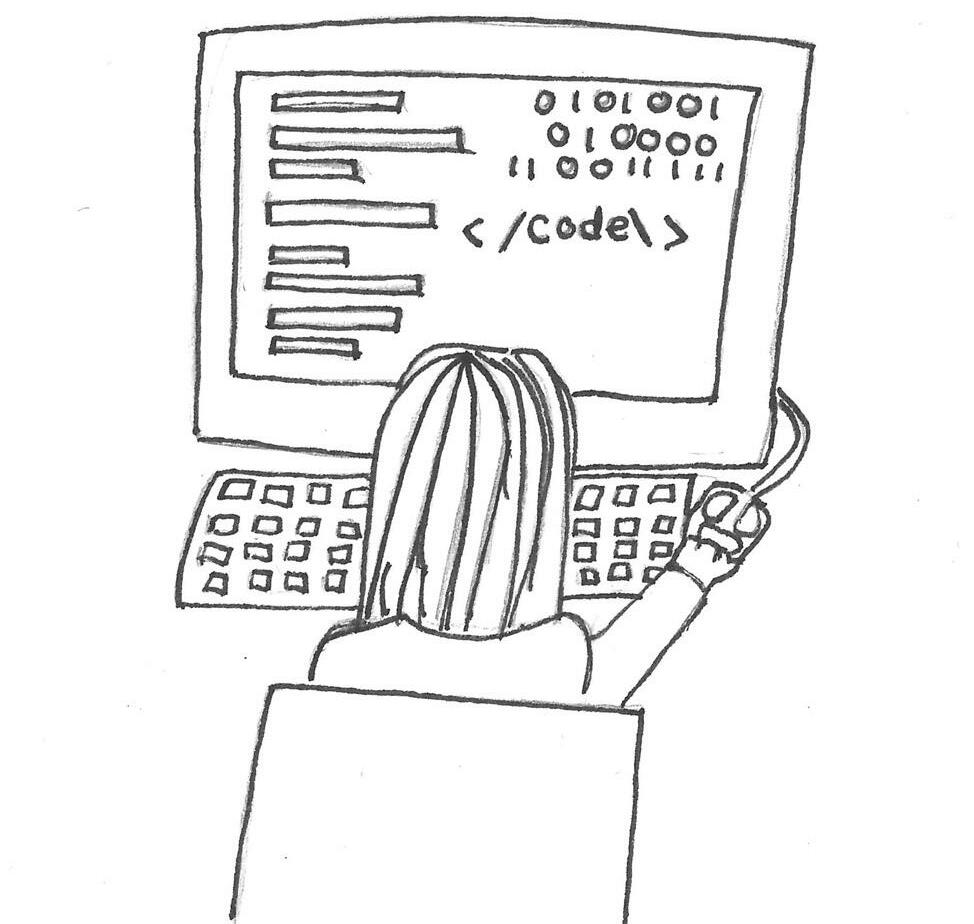
Katie Johnson, a math teacher at ORHS and member of the Flex Committee, notices that students are using Flex when they need to, and are used to the way that it works. “I think that students are finally getting into a rhythm of utiliz

“I think that students are finally getting into a rhythm of utilizing Flex as far as academics go, but I think a lot of stu dents, especially my students, still have nothing to do during Flex...”
ing Flex as far as academics go, but I think a lot of students, especially my students, still have nothing to do during Flex or anywhere they need to go, so it would be fun to have a plethora of options for them to sign up and do,” said Johnson. Johnson’s advisory is not the only advisory that students find themselves
For students in situations similar to Benoit’s, having activities as options during Flex as an alternative will allow for students to not be forced to schedule out and take up space in a different classroom, while doing nothing.
Some of the activities that teachers have proposed and
having minimal work to do during this time period.
“I feel like during Flex, if people don’t have anything to do they kind of just sit there and socialize, so it might be fun for them to have the opportunity to do something else,” said Ce celia Drysdale (‘20). Drysdale explained that she uses the time that she is given well and meets with teachers when necessary; however, she still occasionally finds herself with no work to do. When students do not have any work, some advisors might force them to schedule out of their room and go to a different teacher in order to make room for other students to come in. “When I have stuff to do [during Flex] I’ll schedule out to teachers if I have questions, but a lot of the time […] when it comes to Flex time and our teachers force us to Flex out, it’s hard because we are told we have to do stuff,” said Jenna Benoit (‘21). “Then when we get there, other teachers are asking us ‘what do you have to do?,’ and I don’t have anything to do,” Benoit added.
implemented so far include: climbing the school’s rock wall in the gym, solving Rubik’s cubes, going for walks, coding on the computer, college application support, debate club, and more. The activities cannot be completely random. They must provide some sort of academic benefits for students who choose to participate.
The Flex Committee created a form for staff members to fill out in order to propose enrichment opportunities that they would be willing to run. The form ensures that the opportunity proposed is helpful to students in one way or another. “[The opportunities have to be] instructional in nature. Even though climbing the wall isn’t academic, there’s a reason for doing it, whether it’s teamwork or trust or something like that,” said Milliken.
As of right now, it is difficult for some teachers over oth ers to run an activity based on the subject that they teach, and how often students come in for help from them. The teachers running the activities can choose when and how often it meets; however, subjects such as Math and World Language usually have a full classroom for Flex, leaving those teachers with no availability to run an activity.
Johnson believes that as the year goes on, a better system can take place that allows for all teachers to be able to host an activity, if they would like. This is something that the Flex Committee will be discussing in the future.

“I really think that we need to come together as a faculty and have a larger discussion as a group because I feel like I would almost never be able to run an enrichment opportunity because I always have so many kids in my room,” said Johnson. She wonders if advisories with less students could take in more stu dents, allowing other teachers to run activities. Another option is having the teachers who have less students, in advisory, run more enrichment activities.
If students are ever finding themselves bored during Flex, they should check out one of the activities. Advisors receive up dated weekly emails containing a schedule of what activities are taking place, as the choices vary from week to week. Any other questions or ideas can be directed towards Milliken.
byMelanie Banafato Artwork
Emma Hall
“I feel like during flex, if people don’t have anything to do they kind of just sit there and socialize, so it might be fun for them to have the opportunity to do something else.”
“When that bell on the front door rings, it makes me think of a small-town bakery,” said Kathy Shattuck, co-owner of Sweet ened Memories, a bakery that recently relocated to downtown Durham. “I didn’t realize that’s what I wanted, but being a part of the community and having a small business that people can come to and you know who they are and can have a conversation with. It really pulls together that New England small-town feel. I want that for my kids who live in the community. I want that for myself.”
Sweetened Memories has been in operation since April 2013, serving custom cakes, cupcakes, and cookies originally out of Shattuck’s home in Durham, New Hampshire. It wasn’t until November 14, 2019, that co-owners, Shattuck and Alaina Cre swell and the rest of the Sweetened Memories staff relocated the bakery to 13 Jenkins Court in Durham. It was important for the staff at Sweetened Memories to keep and grow the cozy, homey, and welcoming feel that they had found at their previous loca tion.
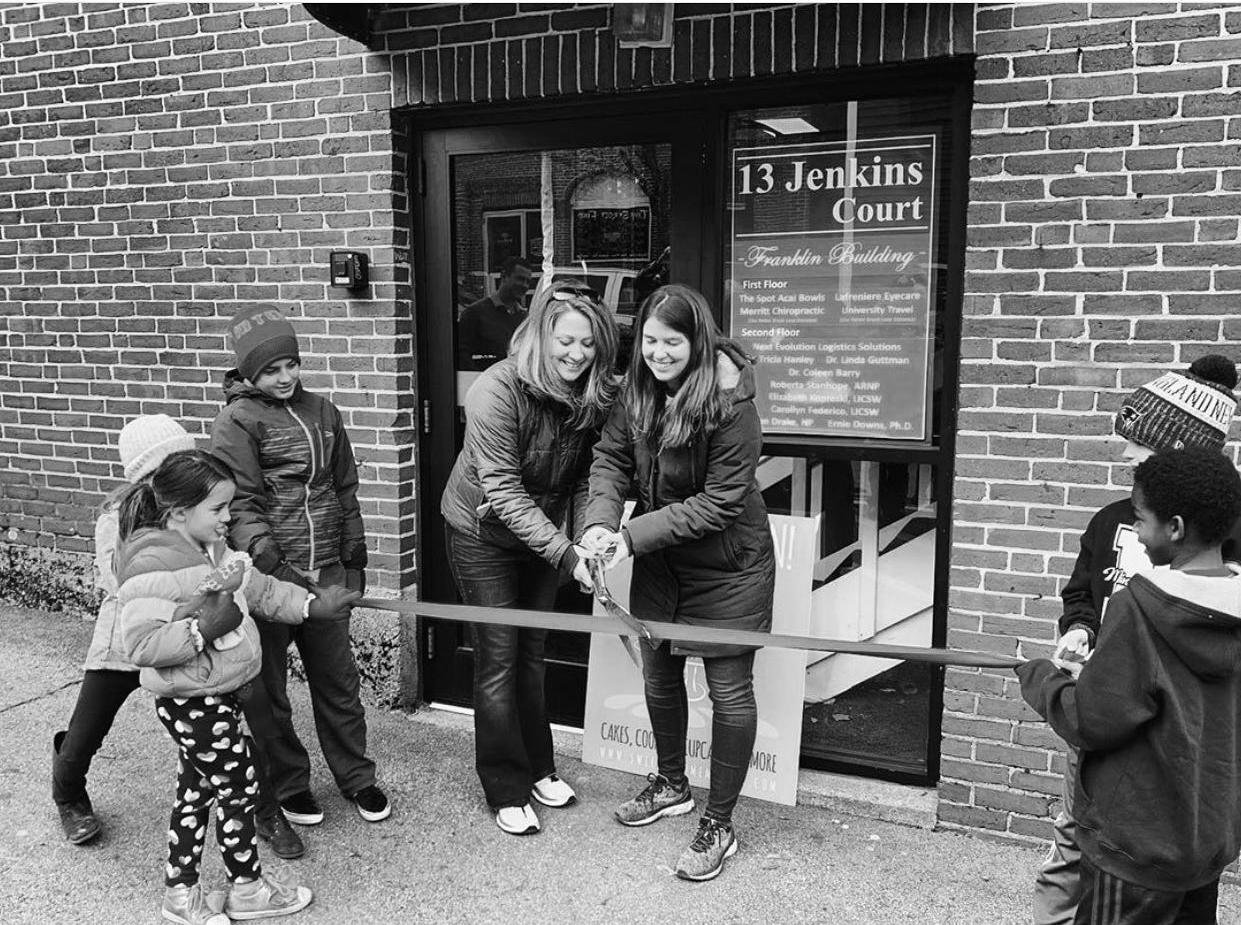
“I love going to downtown Durham and walking around and seeing people I know, but being a part of that now, even more so, is really special,” said Shattuck. “I’m hoping it provides people a great place to get good dessert but at the same time, know that we’re trying to create a product that they like and enjoy because we care. It’s more than just desserts.”
The idea for Sweet ened Memories started as Shattuck making cakes for her friends and her children. About a year later, Creswell joined Shattuck and together made Sweetened Memories what it is today. Shat tuck never went to culinary school, so most of her baking and cake decorating skills were self-taught. “I’ve always been artistic. I didn’t realize I liked doing cakes, but I’ve always loved to draw and paint and all that stuff, so it’s kind of in my blood. I took a few classes at Michaels just for fun and I really liked it. With Youtube nowadays and all the things you can watch online, a lot of it’s self-taught.”
Although Sweetened Memoires has grown since, Alyssa Lamontagne, an employee at Sweetened Memories said, “It’s a fairly big bakery, they have a lot of output, they produce a lot of different cakes, cupcakes, cookies and whatnot but they’re still very friendly and homey feel when you come in.
Creswell agreed to that point saying, “we want it to be wel coming, warm, friendly and fun.”
Brian Keegan, co-owner of Oyster River Cycle and Sport, across the street from Sweetened Memories, and customer described the bakery as, “very bright, inviting, and friendly. The customer service level is very good,” he said.
Lamontagne added, “I think it’s really happy. You walk in and it generally smells like frosting or cookies.”
Caitlin Laughton, Durham, New Hampshire resident and fre quent customer at Sweetened Memories, sees Sweetened Mem ories as something extremely positive for the greater Durham community. “[Sweetened Memories] is something local owned by people who have kids in the school system and that live in the area. It’s a really positive aspect to add, it’s nice that downtown isn’t just bars and restaurants, there’s something different and unique.”
Since December of 2018, Shattuck and Creswell had been seriously considering and working to move Sweetened Memo ries to a bigger space. “I had the vision of what I wanted it to be and what I wanted it to feel like. We’ve dreamt about it for a long time and there’s a lot that goes into it,” said Shattuck. Shattuck knew it had gotten to the point where the storefront was needed, “once it be came overwhelming and busy all the time and it just exceeded the space. It didn’t make sense and it wasn’t functional and after a certain time when it’s not functional it’s not lucrative. You’re not making money if you’re running into each other.” The new storefront has given the opportunity for Sweetened Memoires to expand beyond their former capacity.
“If only words could describe how much work was done,” Creswell said of the move. She also said how time was their big gest challenge. Sweetened Memories was originally projected to open in September 2019, in time for the start of the school year for the University of New Hampshire. “It took a lot of time. It felt like I had two full-time jobs for a while, but now that we’re in its so much better.”
For Shattuck, the most difficult part of the transition to the new storefront was, “being in limbo, because it was in my house and I wanted it out. I hit a wall. It’s kind of like when you graduate from high school, maybe that last month or two before you graduate high school you start to go through this feeling of wanting to move on and I felt that. I was ready for it because I knew how much better it would be for everybody and being able
to have our house back,” she explained.
Aside from space, the connection to the Durham community was something that the staff had trouble establishing when run ning the business out of Shattuck’s home. “Getting to know all these people, and they can come in and grab something and we can talk. I couldn’t do that [in the house]. It’s kind of isolated and removed,” said Shattuck. “It’s a sense of community from a business perspective as well as getting to know more people in town. Before, I would recognize someone coming in once or twice, but now I’m actually able to make an association. It’s just more connected to the community.”
Keegan sees a major benefit in Sweetened Memories’ new location. “It another layer of connection and place for people to go that’s actually in the downtown area,” he said.
Creswell said, “one of the things that’s fun about us is that we have so many clients that we did their wedding, and then we do their first anniversary, then we do their baby shower, and then we do their child’s first birthday so I think that we really like having a client-base and not just the one-off.”
Laughton is one of these returning customers. She has been using Sweetened Memories since her wedding in 2016 and has since used their services for her baby showers, family mem bers birthdays, and various functions at her work. “It’s nice to support a local business but also their atmosphere is very family like and we strive to shop at places like that.”
Shattuck ex plained that Sweet ened Memories stands out from other bakeries in the Durham area because, “we offer a unique product. It’s not just tasty but it’s a work of art. We have a lot of people who are very talented that work for us. It’s something that’s unique and visually appealing but at the same time tastes good.” Shattuck continued by saying, “we have a lot of different flavors, so it’s not just chocolate and vanilla. There are lots of different flavors and things to do. You can customize it as much as you want to.”
You don’t necessarily need to commit to a large, customized cake when purchasing at Sweetened Memories. As explained by Laughton, she said she would recommend Sweetened Memories to, “really anybody. We’ve used them for various life events but even just popping in to get a cupcake just because. I think any body who has an event or something they need it for or they just have a sweet tooth and just want something.”
Lamontagne also talked about the positive aspect of being able to just walk in and grab a baked good with no wait. “Kathy and Alaina have already done such a crazy job of blowing up this particular cake business. Now that we are here, it’s grown even more, especially with having the cases with items are for
sale every day. So, there’s that whole dynamic. People can come in and actually taste things rather than just ordering.”
Creswell spoke about how the expansion to the storefront has allowed the employees to branch out past only serving custom orders. Now, at Sweetened Memories there is a display case made up of different cupcakes, cookies, whoopie pies, and macarons. This was something they had no way of having at the previous location.

“Being here allows us some creative freedom,” said Creswell. “[Shattuck and I] have both really enjoyed brainstorming for the cakes because before it was customers bringing us ideas and we were recreating what they like. What we have the opportu nity to do here is to make what we like. We can put them in the case, it’s not like they have to be ordered for us to make them,” she explained.
With the expansion to the new storefront, Sweetened Mem ories had to hire six more employees. “We hired them [before moving to the new location] because we started the business in my house and it was really important to take the vibe that we had going on in my house over to the shop. We’re like a little family and I really established really nice relationships with everybody. Everyone’s really tight and so I wanted the newer people to be a part of that as we’re going to the store,” explained Shattuck.
Lamontagne, who has been with Sweet ened Memories for only about two months, agreed saying, “this is a really great group of people, everyone gets along really well. Everybody is really helpful and we are all trying to figure it out together.”
Shattuck and the rest of the Sweetened Memories staff put a lot of time and effort into the new storefront, and continue to do so as it’s been opened for a few weeks. “Especially now at the shop, it’s a totally different ball game. It’s a lot more of a financial involvement. It’s all-encompassing. It’s not just, ‘Oh, I have a job and I make cakes.’ It takes over everything,” said Shattuck.
With the new storefront, Shattuck sees it as an opportunity to connect with other businesses in the area. As to where she sees Sweetened Memories going in the future, Shattuck said, “I would like to expand on working with other businesses. I would like to expand on connecting with more wedding venues and building up the small parts of our business.”
Creswell agreed with Shattuck, but added, “I’ve already thrown out a second location, you never know. The sky’s the limit. We are always looking to do more things and add more things. We are definitely not settling here. We’re still looking to build.”
- Emily Hamilton Photos by Kathy ShattuckOnce senior year rolls around, many students find themselves stressing over getting into college, as there seems to be an expectation set for students to go to college straight out of high school. For many, however, there may be a better option. Accord ing to a survey done by TD Ameritrade called “Teens and Money Survey,” roughly 35% of high schoolers in America consider taking gap years.
While many high school students aspire to continue their ed ucation at a two or four year college, this path isn’t for everyone. Rather than going straight to a college, many students take gap years for a variety of purposes.
Oyster River school counselor Jason Baker defined a gap year as a year between high school and college where a stu dent partakes in something educationally based, in preparation for college. The reasons for taking gap years can range from getting travel experience, exposure to the “real world,” or just to mature. Gap Year programs offer students the ability to do so in safe and structured ways to keep the momentum going from high school, into the gap year, and then to college.
“For some kids, it’s a maturity experience. For other students, it’s a safe and supported way to experience life outside of the seacoast,” said Baker. According to the Gap Year Association, 92% of high school students who take gap years are doing so to gain life experiences and grow personally before college, 85% of students take gap years to travel and experience other cultures, and 82% of students take gap years to take a break from aca demics. This information can be found at gapyearassociation.org
During her gap year, Charlotte Clarke (‘18) took two trips to Southeast Asia where she did volunteer work and service projects. Clarke chose to take a gap year because she was phys ically and mentally exhausted from high school and, like many students who take gap years, couldn’t handle four more years of school right away.

Nick Cornejo (‘19) decided to take a year off from education for a different reason. “Personally, the reason why I decided to take a gap year was because I wanted to work and save money, so that when I went into college I was more prepared economically, and more ready to take on the size of the debt that comes with college.” While his motive was mainly economic, Cornejo said his gap year has also helped him mature as a person. Technically, what Cornejo is doing doesn’t fit the definition of a gap year, however that doesn’t mean that his year off isn’t meaningful.
In his year off, Cornejo has spent a lot of his time working. He also helped coach the ORHS boys varsity soccer team in the fall. Cornejo said that he’s also seen a lot of benefits come out of his gap year. “The main benefits are learning more about your self before you go and start learning about a subject before you go and involve yourself in four more years in education, taking a year off to really figure out if that’s exactly what you want to do,” said Cornejo.
Baker said that one of the biggest benefits that comes out of taking a gap year is perspective, and the eye-opening expe rience that some students may experience. [Where we live] “is kind of a bubble […] this is not representative of what the real
world looks like, so to be able to experience that in a safe and structured way [is eye-opening].” For some students who travel abroad, seeing how life is like in other parts of the world and seeing some of the hardships in other countries is one of the biggest things students take away from their gap years. “It’s not to go see the sad side of life, but it is to go see not everything is ‘easy peasy’ as it seems in Durham, Lee, or Madbury,” said Baker.
While many students take gap years for economic or explo ration purposes, gap years are also common for high school ath letes who have collegiate level aspirations. Michael Szymanski (‘21), plays hockey for Islanders Hockey Club, an elite program out of Tyngsboro, Massachusetts. Szymanski said that a lot of athletes that have aspirations of playing at the collegiate level, especially hockey players, find gap years a necessity in order to achieve their goals. Currently, the average age of a freshman college hockey player is 20 years old, according to College Sports Scholarships (CSS). “The difference between an 18 year old and a 21 year old physically, and how mature you can be, is a lot differ ent. If you don’t [take years off] you’re at such a disadvantage to other players in the game,” said Szymanski.
Baker added that usually when an athlete takes a gap year to improve or “bulk-up,” colleges usually still like to see an element of education incorporated as well. Szymanski said that he knows some hockey leagues make it mandatory that athletes are still taking classes, whether they’re still in high school or taking time between high school and college. “The organization I used to
play for, the coach really wanted to enforce the idea that it’s re ally smart that if you’re going to take this time off from school that you still continue your education,” said Szymanski.
For many taking a year off between high school and college, the educational portion is provided through programs. Accord ing to the University of Iowa, the wide range of gap year op portunities available include fellowships, service programs, jobs, internships, and experiences abroad. Programs like National Outdoor Leadership School (NOLS), Thinking Beyond the Bor der, and The Leap are all programs that allow students to travel all across the world, doing fieldwork with experts, volunteering in low-income areas, and participating in other once in a lifetime experiences while still being motivated to learn. This informa tion can be found at careers.uiowa.edu.
While gap years may be beneficial to students in a variety of ways, there can be some difficulties that come with them. Baker said that a common struggle was “finding one that a person likes that they can also afford.” Baker added that the programs that a lot of kids gravitate towards can be pricey. “They can easily cost as much as a private college tuition, and there’s not a ton of fi nancial aid or scholarships to those.”

Economic reasons can heavily influence what high school graduates decide to do after high school. Colleges are expensive, gap year programs are expen sive, post-grad years at prep schools are expensive, so students can be put in tough situations. Some gap year programs can cost as much or more than a full year of college. Some gap year programs, according to CBS News, can cost as much as $50,000. Accord ing to Value Penguin, the average cost of in-state attendance for college is $20,770.
While many students face economic problems while search ing for their gap year, for both Cornejo and Clarke, most of the struggles of taking a gap year came socially rather than eco nomically. “A main struggle of taking a gap year is sometimes you don’t really know where you belong. You’re not in high school anymore so you don’t have your high school friends, but you’re not in college so you don’t have the college friends, so you have to find how else you can make connections and make friends,” said Cornejo.
Clarke had similar struggles socially during her gap year. “I had major fear of missing out from all my friends going to college and not getting to be a part of that. I was terrified of just going abroad and missing out on everything I was so used to,” said Clarke.
While Clarke and Cornejo both have had social struggles during their gap years, these struggles will likely fade away in
college. After his gap year, Cornejo will attend Plymouth State University in the fall of 2020, where he will go into the crim inal justice department. Cornejo is hoping to become a police officer after college. [Becoming a police officer] “has just always seemed like something that has been fitting for me, because I like being in the community and being active.” Cornejo knew that this is what he wanted to do leaving high school, but he was unsure how to do it. Cornejo said that during his gap year, he’s been able to take time to do more research on how to accomplish his goal. “Taking a gap year definitely allows you to prepare for what you want to do without all the distractions that are college and social life.”
After her gap year in 2018-19, Clarke is currently attending the University of New Hampshire. Clarke is majoring in social work, and is hoping to work with children in either adoption, or phanages or foster care after college. Looking back on it, Clarke is happy she took the gap year. “If I could do it all over again, I 100% would. The experiences I had were once in a lifetime,” said Clarke. During her gap year teaching English to kindergarten classes in Bali, Indonesia, helping build a playground in China, making water filters in Cambodia, and cooking to help feed malnourished children in a small town in the Philippines. Clarke said that being from the Philippines really made her experiences more mean ingful.
Szymanski added that he still isn’t sure whether or not he will take a gap year in the future, as he sees it as a potential risk. “I’ve seen people where they’ve gone to take a gap year and it gets to a point where you realize that you’re chasing a dream that you can’t really catch. He added that there are downsides for athletes who fall short after taking gap years to achieve their goals.
“It’s a tough decision you have to make because if you’re 21 years old and you’ve taken multiple gap years for athletic reasons and you don’t catch that dream that you’ve been striving for, it puts you in a tough situation socially because they’re living in dorms with kids who are two or three years younger than them, which can be hard at times,” said Szymanski.
Clarke said that she recommends taking gap years to everybody that she talks to. “I was lucky enough to know what I wanted to do with my future, but a lot of kids come out of high school not knowing and just pick something just to say they have a plan. You’re young and not supposed to have your whole life figured out,” said Clarke.
- Alden Swiesz Images from Charlotte Clarke“I definitely don’t remember the last time I went a full day without juuling in school,” said Sarah*, a student at Oyster River High School who like many of her peers, iden tifies as addicted to nicotine. Sarah is only 1 of the estimated 37.3% of 12th graders nationwide who reported vaping in the past 12 months, according to the National Institute of Health. This public health concern has begun to take lives and cause panic in every state and community across the country. Oyster River is no exception.
Tucked away under a stairwell or locked behind a bath room door, Oyster River students are among the latest vic tims of the e-cigarette industry. The world of telling secrets in the bathroom has transformed into feeding a deep rooted issue of nicotine addiction.
Vapes and e-cigarettes rose to popularity in the mid 2000s as an alternative to traditional cigarettes. MOR has detailed at length the history of vaping through Devan Mclain’s article series, “JUUL,” focusing on the marketing tactics of Juul. Although these products were first market ed to a generation of tobacco users as a means of quitting, these companies have captivated a new generation: one that has fallen to the tactics of big tobacco just like their prede cessors. Oyster River has started to make strides to combat this issue.
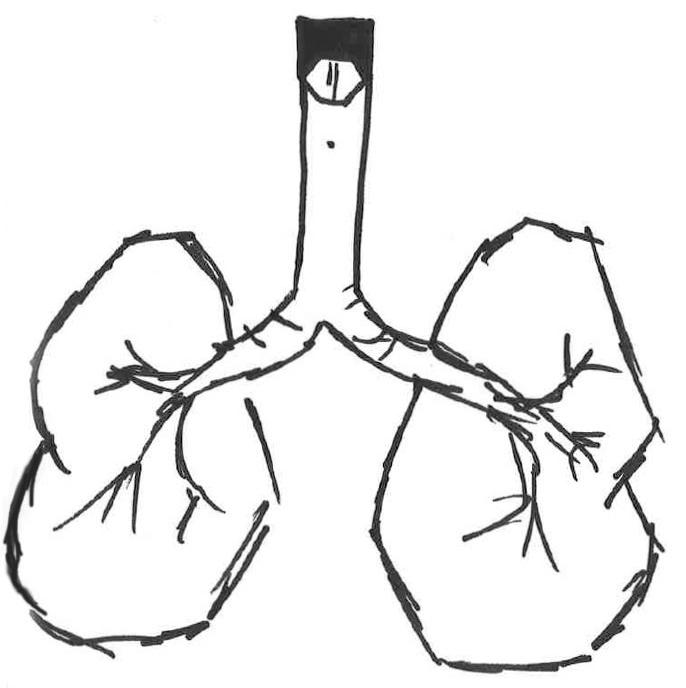
In mid November, Oyster River High School wel comed Allyssa Thompson from Breathe NH, for a week of informational sessions for all students and faculty in the building. Thompson works as the Director of Programs at Breathe NH, a non-profit organization working to improve lung health and combat lung disease in New Hampshire. “This is an industry that is unregulated and is taking a page right out of the playbook from big tobacco[…] This is about young people recognizing that they are being target ed, and it’s working,” said Thompson.
Although not all took Thompson’s talks in a serious manner, it did send a shock wave of urgency and created dialogue throughout many students in the building who rec ognize addiction in themselves and their peers. The reality of
Oyster River is that students are addicted and many recog nize that it is a problem. Sarah has been vaping for two years and estimates she uses one Juul pod per day. “I definitely do consider myself addicted to nicotine. When I first start ed I told myself I wasn’t gonna get addicted but as I kept buying, I found myself becoming more and more reliant on it on a day to day basis,” she said.
Sarah noted that for her, vaping started as something she did with her friends but it has spiraled into much more. “It’s not a social thing for me anymore, which is kind of scary: it’s a necessity.” Sarah is definitely not alone when it comes to battling addiction. Following Thompson’s talks, I talked to a number of my peers who acknowledged that their vap ing habits are problematic, but did not identify themselves as addicted to nicotine.
“Young people don’t always identify as having an ad diction. It’s more about noticing what that behavior looks like,” said Thompson, adding that it’s important for indi viduals and the people around them to recognize signs of addictions. “If you are sleeping with your vape and it’s the first thing you think about in the morning, that’s addiction. If you can’t make it through your classes without going to the restroom, if you can’t make it through practice, that’s addiction,” she said.
Addiction has become a large part of many students’ school days. Sarah explained that at the peak of her usage, “I would leave class a lot […] it became obvious as to what I was doing.”
Sarah is not alone when it comes to students who feel that their addiction has had an impact on their academic lives. Another student who expressed concern about addiction was Julia*. “I would be in [class], taking a test, and all I would think about is ripping my juul,” she said. Julia added that although she hasn’t ever vaped in the building she has had to think of creative ways to get her fix while at school, and said, “I would leave it in my car and say I needed to grab my lunch to go out and smoke.”
Vaping hasn’t just made an impact on student’s academics, it has also had an im
mense effect on their athletic lives. “I definitely have lost a lot of weight and muscle from [vaping][...] When I’m playing my sport I can definitely feel the effect two years of juuling has had on my lungs,” said Sarah. Similar to Sarah, Julia has also noticed the severe impact vaping has had on her athletic life. “When I’m playing my sport I can definetly feel shortness of breath.”
Whether it’s in the classroom or playing a sport, stu dents are severely impacted by vaping and many struggle to quit. The accessibility of vapes and nicotine products for students at Oyster River poses a large barrier for quitting. Julia noted that if she doesn’t have her vape on any given day she could just, “go out downtown, not get carded, and get a disposable.”
Vaping is an area with many unknowns and one that is constantly evolving. Over the last few months, with deaths and severe lung injuries occurring at a national lev el, students are acknowledging that vaping is dangerous for them. Some, like Julia, have even devised plans with their friends to incentivize themselves to quit smoking.
size fits all policy for school districts around vaping. We are seeing that schools are recognizing that students are addicted and so it’s about connecting them with treatment options and what programs are available.”
Students at Oyster River are looking for ways that they can quit. Sarah added that, “if the tools were provid ed for me to end my addiction, I would definitely take ad vantage of the opportunity. I think quitting nicotine is a mental battle that kids our age can’t beat alone, so support would significantly help.”
In the weeks following Thomspson’s presentations, the district welcomed a new Master Licensed Drug and Alcohol Counselor (MLDAC), Nichole Terhune, who will work with students individually and as an entire student body. “We have to break the stigma around addiction and mental health. We need to be able to talk about the hard stuff. We need to be here for each other with compassion, understanding, and kindness,”Terhune said.
Kimberly Wolph, ORHS School Nurse, spoke on the benefits of the new LDAC. “Having an additional re
“Me and my friends know it’s bad so we share one,” she said, adding that, “we made a deal that after this one runs out we aren’t going to smoke at all and our punishment if we [smoke] is the other two girls get to pick out the other girl’s outfit for a day.” Ideas like this are not long term solutions for nicotine addiction. However, this is a starting point for some when identifying the issue.
With many students now aware of the dangers that vaping presents, many are looking for ways to quit. Unfortunately, this is where they run into a number of additional barriers. “Vaping hasn’t been around long enough to have the traditional nicotine replacement or therapy options [...] The other thing is what traditionally has helped adults to quit tobacco products like nicotine replacement therapy has been found ineffective with mi nors,” said Thompson.
Although there aren’t a whole lot of medical inter ventions that can be done, schools across the state are taking steps to help students combat the severe addiction that many face. Thompson said that, “there is no one
source in the building to help students is essential due to the rise of vaping usage throughout the middle school and high school. The LDAC is a highly trained profes sional who is skilled in working with students who may be struggling currently or who have struggled and need guidance,” said Wolph.
Terhune is optimistic about the future and looks to address this issue immediately. “Our high school students want to be heard and not judged. If I can give Oyster River students a safe place to talk about substance use, maybe I can help them dig deeper into understating their struggles,” she said.
Thompson concluded by saying that, “before, it was about catching kids who were trying it and experiment ing. Now it’s about recognizing that the [students] are addicted and there is a serious problem.”
have been changed for anonymity
*names
- Joe Morrell
“This is an industry that is unregulated and is taking a page right out of the playbook from big tobacco[…] This is about young people recognizing that they are being targeted,”
There are days that I, and I’m sure many of my classmates, will check PowerSchool obsessively waiting for a teacher to put in a specific grade. Even as I scroll through, barely looking at anything except that grade, I see my Grade Point Average (GPA) looming above my quarter grades. Represented in PowerSchool by four dig its and four stars, a wave of overwhelming disappointment washes over me each time I see it. This number holds a certain power over my life in its ability to remind me of each of my weakest grades from the past four years, while also encapsulating all my hopes for college admissions.
A GPA is not the summation of who we are as students, al though it can often feel that way. It’s also not the most important thing on your transcript; it’s simply one number used to summarize your academic performance. But it’s not the perfect summary tool. It doesn’t show your strengths, weaknesses, the rigor of your class es, or whether you’ve improved over time. GPAs are a long standing tool used to compare students to each other and to measure their overall academic performance, but they hide a lot. It’s also highly subjective depending on your school’s grading and reporting poli cies.
A summary statistic that so poorly represents the student is useless, and the stress they cause is damaging. Therefore, I believe that the Oyster River Cooperative School District (ORCSD), and any other school district interested in their students’ well being, should no longer track and report GPAs.
When I first decided to write this article, I planned to write about why our GPAs should be weighted. I began to build my argu ment based on two classic arguments for weighted GPAs: the first was that we should make our GPAs as similar as possible to the way colleges would view them, the second was that your GPA should show the difficulty of the classes you’d taken to more fairly demon strate your successes.
I started by talking to Tara Scholder, the University of New Hampshire (UNH) admissions counsellor for the Seacoast area. During our conversation I realized two very important things, the first was that each college has their own system for weight ing GPAs and they’ll reweight your GPA according to what they believe is important, so there’s no point in trying to weight GPAs the same way they do. The second thing I realized was that they believe your transcript, which includes the grades from every class you took during high school, is a more accurate indicator of your success.
Your GPA takes all of the information on your transcript and tries to put it neatly in a box, but your transcript will show your im provement over time, the difficulty of the classes you took, and your strengths, which will probably be more relevant if you’re applying to a specific program. Using all of a student’s grades to understand their academic career will give you a more accurate and balanced impression of their performance.

Heather Machanoff, a school counselor at ORHS, explained that the biggest use for a GPA is to help students get into college. Within ORHS, GPAs are used for the internal class ranking, honor roll, and organizations like National Honor Society (NHS). Mach anoff said, “it’s not even on our radar, as far as our office, in terms of meeting with students. It’s not anything that’s ever really talked about unless they come in for an insurance discount or to send stuff to a scholarship or some kind of program that’s asking for it.” She also said that it could help students judge their fit at various colleges, but I’ve found that it can be hard to judge where your GPA falls on the college’s scale when you don’t know how they weight it. If the counselling department doesn’t actually use GPAs, and they don’t actually give you an idea of where you’ll be able to get into college, GPAs don’t have any significant added benefits.
A weighted GPA means that classes will factor differently into your GPA depending on their difficulty. For example, if an A in a typical class is worth 4.0, an A in an AP class might be worth 5.0. While colleges often re-weight your GPA to create a standardized summary statistic, it’s important to recognize that most college admissions counselors acknowledge that your GPA doesn’t show everything about you. They also understand that every school has a different way of reporting student grades and GPAs. To compen sate for this they will re-weight your GPA so that it matches the system of reporting they use.
When you see the GPA that the college presents, it probably won’t match the reporting system that your school uses, so it won’t actually tell you where your GPA falls compared to the average. For example, Tara Scholder, the Seacoast area admissions counselor at the University of New Hampshire (UNH), explained that UNH re-calculates GPA to include only the core classes and to weight Advanced Placement (AP) classes a full point higher and honors classes half of a point higher. However, Oyster River includes all classes that students take and doesn’t weight them. This means that the 3.5 that UNH reported on their website as the average GPA for enrolling students is completely different from a 3.5 at Oyster River. The biggest benefit of having a GPA is knowing where you fall compared to a college’s average, which should give you an idea of how likely you are to get in; yet, your GPA doesn’t actually tell you where you fall when colleges re-weight it to follow their own system.
Scholder explained that they consider students within the context of their school. She said, “we do not compare students, in terms of admissions decisions, across (high) schools.” Even though they create the standard to consider students’ GPAs, Scholder said, “it gives me a first, initial impression of a student. But we do dig deeper and look at the transcript, because there’s a lot that can be behind a GPA.” She explained that at the end of the day, the deci sion depends more on the student’s transcript than their GPA.
When I was trying to determine which colleges were worth
applying to and which were “matches,” “reaches,” or “safeties,” their average GPAs were stuck in the front of my head. I was terrified that they wouldn’t look beyond my GPA to see the classes that I’d taken and the individual grades I’d gotten in those classes. The more I toured schools and spoke to admissions counselors and our school counselors, the more I began to realize that this was a largely un founded fear, and that your GPA says very little about you.
If college admissions counselors and school counselors recognize that your GPA doesn’t show everything about a student, why do we continue to use them? Machanoff said, “people have a really hard time separating the number from the learning. So if we took that GPA away I feel like people would still be calculating it on their own in a way. I think that we think that that’s just what we’re supposed to be doing, that’s just how we measure things.”
While discussing the downsides to having GPAs, Machanoff said the issue isn’t the GPA, it’s the mindset our society has around education. She said she believes that as long as numbers are used to measure success, the issues we’ve found with GPAs will persist. Machanoff mentioned that competency based grading is meant to drive a shift away from this mentality. But I believe that the biggest issue with the GPA is that it perpetuates the idea that you’re either good at school or you’re not, while individual grades show a more complete picture. GPAs don’t allow students to have strong subjects and subjects that you struggle with. This makes even less sense when you remember that not every student is going to use high level math or writing for the rest of their lives. So why is it included in the sum mary of their academic career? Considering individual course grades allows the student to be human; they can fail, succeed, and grow over the course of their four years.
Scholder and Machanoff both considered a student’s transcript to be a better indicator of their academic performance than their GPA. Scholder said, “the overall GPA might be quite modest because once you get a lot of Cs and Ds on your transcript your freshman year, it’s really hard to bring those up because you’re looking at an average. So the GPA for those students might be quite modest, but when you look at the transcript you see they’re getting all As and Bs in their junior and senior year, and that’s much more important to us.”
While your grades matter freshman year, they don’t necessarily portray what you’re like as a student when you’re a senior. Stephanie Ev ans (‘20) spoke to the effect that this has had on her. She said, “I think it increases stress personally because I messed up freshman year, I really messed up, which is something that is shown through my GPA and it’s not gonna go away no matter how many As I get in my junior or senior year.”
Evans continued on the topic, “obviously people change from when they’re fourteen to when they’re eighteen. I know colleges see that, but it’s stressful to think that one mistake you make freshman year can cause you not to get in somewhere.” Why is it that when we want to con sider a student as they are today, we start with a summary statistic that views their performance over the past four years equally and allows
for very little growth?
GPAs attempt to sum up your entire education with one number, but they end up hiding the person. Machanoff said, “everybody has strengths and weaknesses, so just because you have that GPA doesn’t mean you’re really, really great in all areas. You might be really, really great at social studies and English, okay at math, and maybe science is your struggle area. But you still have a respectable GPA.” GPAs can create the illusion that if a student isn’t successful in all subjects, they’re a bad student or stupid. If a student believes that they’re not capable of succeeding, they might give up on school as a whole.
On the flip side of this, in my experience, students who strive for a high GPA will often take classes they know they can be successful in rather than classes they find challenging and engaging to maintain their GPA. This encourages students to do less meaningful work for the sake of a better grade rather than hard work in a topic they find engaging.
Machanoff believes that to encourage students to work for learn ing rather than for grades we need to change the way we think about education. She said that this new mindset was part of what they hoped to achieve at the middle school through competency based grading. She said, “I think it’s much larger than just getting rid of the GPA. It’s a mind shift in how we view education and how we view what education should be.” However, by removing GPAs, we would encourage students to look beyond a single number when they judge their academic successes. They would be able to see their current performance in individual classes without the average of their past grades hovering over them.
Machanoff pointed out that it would be difficult to get rid of GPAs when some people feel strongly that we should continue to have them. She said, “when you look at things like education, people are referencing their own experiences. ‘When I was in high school we had a GPA and it wasn’t a problem,’ or ‘we had honor roll, what’s the matter with that.’ They think in isolation of their own experi ence sometimes without taking into account that society is changing, students are changing.”
While I understand where people are coming from when they’re frustrated with change, I don’t see what added benefit that GPAs have. They cause more student stress than they’re worth and don’t allow students to recover from their weaker grades. As long as GPAs exist, students will use them as a convenient measure of their perfor mance during high school and, in some cases, their ability to succeed in the future. Students who want to keep GPAs might believe that the pressure that comes from them is a positive influence, but I suspect that if they went without them, they would feel differently.
GPAs do little more than provide a standard metric to compare students’ performances, causing needless stress, especially with PowerSchool, where students find their GPA at the top of the screen every time they check their grades. Education isn’t meant to be a competition, it’s a valuable opportunity. But when students are provided a single measure that they can use to compare themselves to their peers, they’ll use it. “If you have the skills you need, does it matter how you compare to the person sitting next to you?” said Machanoff.
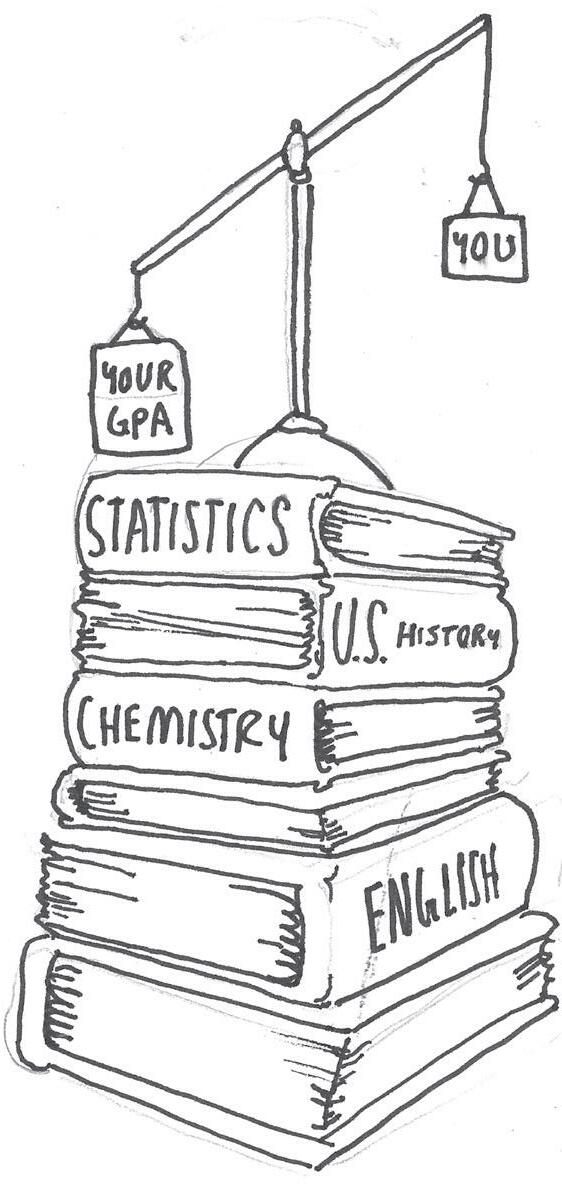
Machanoff was right. If the purpose of education is to provide the skills to succeed in the real world, there’s no reason that every student should have to succeed in every class they take. Your weak nesses in one area shouldn’t make your successes count for less so that you can be conveniently summed up in a single number.
- Susanna Serrano Artwork by Jane SchwadronA few weeks ago, I was in Maine with my mom. I walked into a boutique and saw this sweatshirt that I automatically felt attached to. I knew I would wear it every day and thought it was unlike anything I had before. That day, I tried to talk myself out of it, and tell myself I didn’t need it. However, the next day, I found myself returning to the same store, ready to get the sweatshirt. I was super excited to get it, and told myself I’d wear it all the time. It was fairly expensive, but my mom bought it for me as an early birthday present, and I told her I really, really wanted it. I got the sweatshirt, put it on right as I was walking out of the store, and loved it.
The next week, it was hanging up in my closet, and was nothing special to me. I had wanted it so badly, begged for it, and finally got it, but within a matter of days I wasn’t especially appreciative or grateful that I had it. It was just another sweatshirt that I didn’t need.
Looking back on this, my gratitude probably ended with me saying “thank you” to my mom. However, I’ve come to realize through writing this article that grati tude is necessary in everyone’s life, and it is closely tied to happiness. I believe we all, including myself, should be more appreciative of what we have, and strive to practice gratitude more in our everyday lives. As a generally afflu ent community, we as Oyster River students aren’t always being aware of the value of what we have and how grati tude will benefit us. Around this time of year, gratitude is especially important.
In today’s society with so many innovative and exciting things coming out each day, month, and year, it is easy for us to blow off gratitude, and forget its importance. To me, gratitude is being thankful and appreciative of what you have in your life, regardless of outside factors.
According to “What Gets in the Way of Gratitude?” by the Greater Good Magazine, “a society that feels entitled to what it receives does not adequately express gratitude. Seen through the lens of buy ing and selling, relationships as well as things are viewed as disposable, and gratitude can not survive this materialistic onslaught.”
Going along with this idea of “disposable” items, there are so many options and versions of products to get that many people are constantly searching for the next best thing, and discounting the value of what they have. This leads people to being unappreciative of what they have be cause it is never good enough compared to what they could have. Tessa Lippmann (‘21) said, “we are never satisfied. I think it comes from a place of insecurity because we don’t feel confident with the things we have. It’s kind of like we are comparing ourselves to each other, which is never healthy.”
This feeling of dissatisfaction can lead to people just buying more, in an attempt to reach that level of satisfac tion they desire. However, just buying more is not possible for a lot of the students in this community. “There are a number of students here [at Oyster River] who can’t financially compete. If you don’t have means in this com munity, this can be a really hard place to be,” said Brain Zottoli, ORHS humanities teacher.
This issue of being able to keep up financially is related to school culture. Scott McGrath, ORHS humanities teacher, spoke to the idea of certain trends, like AirPods, and how, “students receive praise for having attained those items.” When this is the case, and students are gaining attention for certain products they own, it fosters a sense of competition and necessity to get that thing.

McGrath spoke to how this relates to this community. “Oyster River is comparatively, with neighboring towns, among the more affluent districts in the state of New Hampshire (NH). It’s also one of the most high performing districts in the state of NH, and I think that definitions of popularity and status are embraced by the community here.”
If the items people have are centered around com petition and popularity, no wonder people aren’t being grateful.
It seems to me that often times we become blinded by the idea of something trendy and popular, we lose sight of being appreciative for it, and realizing that we’re lucky to have it.
However, this phenomenon of being so focused around
getting new things is not the case in all cultures. Zottoli has had the opportunity to travel to and experience many cultures over the years. He’s traveled to Tanzania with a group of ORHS students the past two years. “What I see in these cultures is that there’s a huge mentality around maintaining what you have for as long as you can, especial ly if it’s nice.”
Where this differs from the United States is that when people have something that is deemed “nice,” it seems like it doesn’t carry the same weight as it would there, and it’s not all about maintaining it. More often than not, the spe cific item, whether it be a shirt, phone, or bag, doesn’t seem so special after you actually own it.

Hannah Jeong (‘21) gave an example of how she has seen the idea of things not being “good enough” in her life.
level of happiness that goes with being content with what you have.”
Often times many people search for happiness in mate rialistic things, so they always buy more to seek that. For richer people, a category that many ORCSD families fall under, this is possible, and most likely occurs a lot more. However, “there can be people who are very wealthy and have everything in the world they’ve ever wanted mon etarily, and then you can find people who are in extreme poverty [...] but those poor people, if they’re very grateful for what they have, they’re gonna have overall higher life happiness and satisfaction than the wealthy people who have everything but aren’t satisfied,” Ramsay said.
Regardless of wealth levels or social class, most every one loves receiving gifts. I always find myself wondering
“In my closet, I’ll be like ‘I have nothing to wear. I need a bunch of new clothes, and I want a new wardrobe,’ but I probably have a bunch of completely fine, usable outfits that I could wear,” she said.
This mindset leads to a constant cycle of things never being good enough, because people are always seeking a new standard for what is considered good enough.
Hadassah Ramsay, a local psychologist who owns her own practice in Durham, spoke to this idea of standards. “In terms of people always wanting more, if someone is setting their goals for higher and higher they might get that, but then after a while it’s not going to feel new anymore, and so they’re going to be unsatisfied again,” she said.
With a constantly changing baseline of satisfaction, I believe that a lot of things are taken for granted. “People who are often not feeling satisfied, are also not feeling grateful for what they have,” Ramsay said.
To me, something that is really important to seek in any situation is happiness. An example of this could be getting a new bag. That happiness you get from the bag is most likely short term. You buy the bag, excitedly carry the bag for the first time, love it, get a lot of compliments that day, but then that happiness might go away after that first day. Soon enough, you’ll think the bag isn’t good enough, and you will turn to the next bag, or item, you want. Speaking to Tanzanian culture again, Zottoli shared, “I just feel they’re happier, you know there’s not this need to kind of always get new things, and I think there’s a
what the gift will be, and excitedly anticipate receiving something new. I’m sure this is the case with a lot of people, and Robert Sapolsky, a neurologist who studies do pamine release in the brain, has conducted research to back this up. Dopamine is a chemical in the brain most notably known for being responsible for pleasurable reward and feelings of happiness. According to “Shopping, Dopa mine, and Anticipation,” by Psychology Today, through an experiment with monkeys, Sapolsky found that dopamine is released in anticipation of a given reward, and not when the reward is received.
If someone asked me and my peers when we are most happy about a reward, I think most of us would say when we get it and then are able to use it. Jeong had a similar thought, and said, “I think when you get it [is when you are most happy] because you’re excited to use it, and it’s kind of fun to have someone give it to you and [for them to] do a nice thing for you.” However, if this research is really considered, I think most of our excitement really does come in anticipa tion.
Thinking about the recent holi day season, this as pect of grat itude
“We are never satisfied. I think it comes from a place of insecurity because we don’t feel confident with the things we have.”
gifts. There is something about that image of the wrapped presents under the tree, ready to be opened, that leads to so much anticipation and happiness, at least for me. It’s always been exciting for me to think about what could be under the wrapping paper of each present.
While a lot of the anticipation is before, there’s also a window of happiness once the gifts are in our hands. Zottoli spoke to this idea of that initial happiness. “Right when we get stuff, like with the holidays, we’ll get a whole bunch of stuff that we don’t need, and we will be
some, this may be going out of your way to thank some one for a gift, or something they did for you. For others, it could be looking at what you have before purchasing some thing and considering if you’re being appreciative of what you have, instead of just buying something new. Another strategy that Ramsay suggested is every night writing three to five things that you feel grateful for. “I think if people did that, they’d come to really appreciate what they have,” shared Ramsay. I had never really done any of these strategies before, or been aware that this may help me in
super psyched that morning, and then we’ll get bored by the afternoon, and then we’ll be moving on to the next season’s fads...and that mentality of not really appreciating the things that you have, or not being content, is a hard mentality to maintain.”
This research on when the happiness and excitement is in full effect provides an explanation as to why we so often find ourselves always buying more. It’s an inevitable reaction within our brains. However, everyone can try to combat that by taking a step back, and trying to introduce gratitude more regularly into their lives.
Before getting into ways to practice gratitude, it’s important to note some things that have potential to get in the way of this practice. According to “What Gets in the Way of Gratitude?” by the Greater Good Magazine, enti tlement can be a factor as to why it is hard to be grateful for some. The article said, “this attitude [of entitle ment] says, “life owes me something” or “people owe me something” or “I deserve this.” In all its manifestations, a preoccupation with the self can cause us to forget our benefitsand our benefactors or to feel that we are owed things from others and therefore have no reason to feel thankful.”
If we all try to take a step back from our lives, and acknowledge that we may be acting in this manner, it will allow for a more successful pursuit of gratitude. I recognize that this is not easy to do, and I’m sure I will struggle trying to take this step back as well. However, it’s evident that it is necessary to implement gratitude, so I feel it is worth a try.
There are a number of ways to achieve gratitude, and everyone will have a slightly different way of looking at it. It doesn’t have to be becoming grateful for everything you have at once. It could work to start small, and just try to be grateful for one item, or one area of your life. For
other areas of my life. I think I was absorbed in everything else going on around me that I forgot how important grat itude really was. However, now, I realize that is a valuable practice to implement into my life.
I have not, by any means, mastered gratitude. By looking into this subject, I have come to realize that I’m not as grateful as I should be, and I definitely didn’t realize how important it was, and I think this is something I have in common with a lot of my peers. To me, it seems like a really big task to try to break the habit of being ungrate ful. I’d encourage you to do the same: to look at yourself objectively and ask yourself if you’re practicing gratitude, or taking what you have for granted, and if so, how can you implement it into your life for the better?

-Holly Reid Artwork by Hannah Jeong
“In terms of people always wanting more, if someone is setting their goals for higher and higher they might get that, but then after a while it’s not going to feel new any more, and so they’re going to be unsatisfied again.”
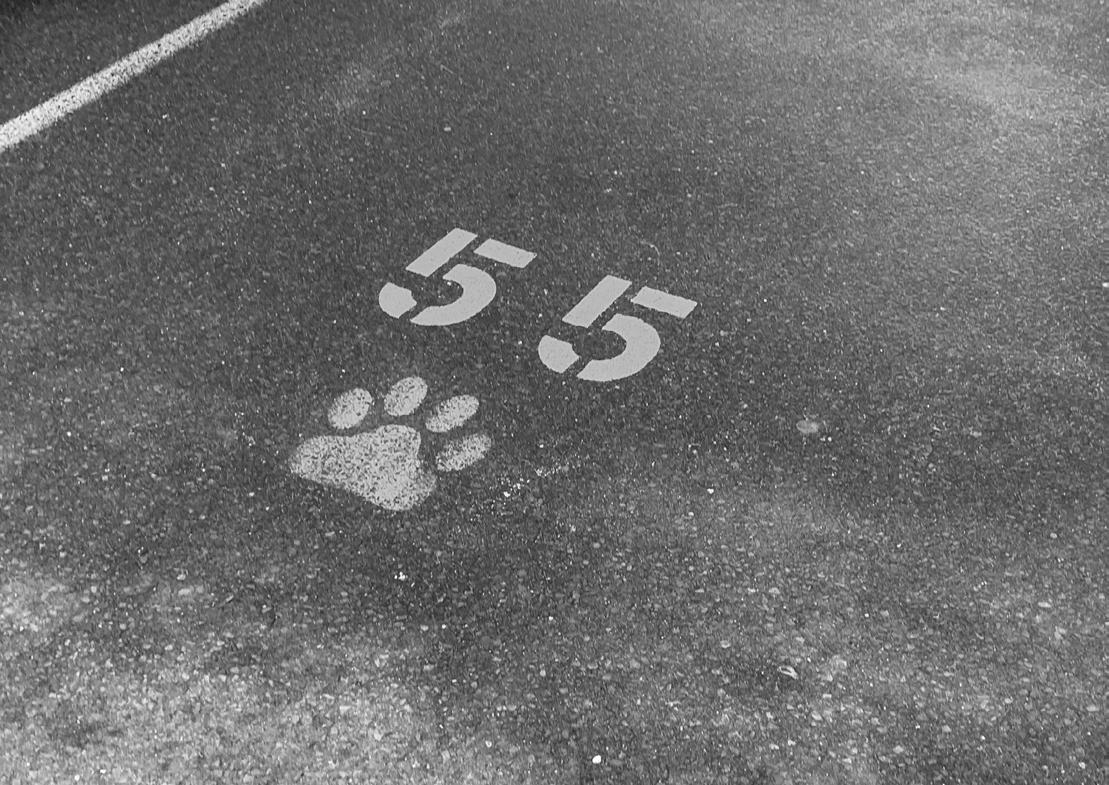
Last June, I sat on my laptop during Citizen Education, fran tically typing away on Change.org about how much I didn’t like the new parking system being incorporated. Now, I’m here to say the near opposite.
I’m sure at least one person saw my name next to an Op-Ed about parking and thought ‘oh boy, here we go again’ because of how strongly I opposed the parking change last June. Like any good politician, I’ve flip-flopped. This parking system really works. It’s not perfect, but there is a lot more order than the wild west model of years past. Twice now, I’ve sat down with Mr. Milliken to discuss the parking system (once in June 2019, and again the following November), and both conversations held a common theme: we’re moving in the right direction, but future changes will be necessary.
Up until last year, the parking system was as follows: once you had a permit (determined by lottery), you parked wherever you wanted. Just over 200 spots, and this bred issues. Not every one was able to get the spot they wanted, and as a result of this, both parents and students alike were upset. Without assigned parking, parking without a permit ran rampant throughout the school’s parking lot. This system was chaotic and generated an exponentially higher amount of parking offenses. This created busy work for our administrative team, and it took time away from more important subjects.
This system worked the most for seniors, who received priority parking. It was a tradition that seniors received spots before everyone else, and when we lost that privilege going into our senior year we were upset. Two petitions circled the grade, parking became a hot discussion topic in any class we found downtime, and we just weren’t happy with the change. We ended up getting our priority back along with a few other changes.
It will take much longer for me to describe the new system, and that is part of what makes it so great. The system has what its predecessor didn’t: structure.
The lottery pool begins with seniors who carpool receiving the first chance and a virtual guarantee at a parking pass. This is followed by seniors who do not carpool, then juniors who carpool, and lastly juniors who drive themselves.
In order to be considered a “carpool driver” the spot must be used by 2 or more drivers who not only have licenses, but also vehicles they would be driving to school if they didn’t carpool. This is meant to reduce the number of students in the lot, and it does a great job at that. Instead of two students taking two cars, they take one and can switch the pass between each other’s cars.

Spots all are now assigned to a specific pass, meaning every day you come to school you are guaranteed your spot and anyone else who parks there will receive a “real-world” punishment, which has deterred illegal parking (I don’t know many people who enjoy dealing with tickets or their car being towed).
In order to make sure these spots are going to their rightful owners, Mr. Blouin is often in the parking lot checking cars to make sure they have a pass and are in the correct spot. This re duces stress coming to school in the morning, as you no longer wonder whether or not you’ll be able to park, even though you have a pass.
These consequences, along with a well-developed system, make parking right now easier than ever. Instead of rushing to school to battle for a spot, I arrive on my terms and park in my spot. The only time spot 42 wasn’t open for me was when my classmate in spot 43 accidentally took it, and for the day we just swapped. Organization and order have made things much easier.
While a parking committee similar to last year hasn’t been formed yet if one is it will have long term problems to solve. The solution they created has worked for the current size of the school, but if class sizes continue to grow at the rate they have, the percentage of students who park will go down by the year. They will need further change, whether it is adding more space, forcing carpools, or only allowing seniors to park.
Changes to the system could come in many forms, but I trust the problem-solving team in charge to make the right decisions for the school community moving forward. They certainly proved me wrong last year, and hopefully can slowly but surely improve the parking system for years to come.
In short: I was wrong. It’s not the first time it’s happened, and it certainly won’t be the last. The parking system last year was admittedly a mess, and my peers and I were stubborn when presented with change. For over a week my energy was focused on petitions and other anti-parking change tasks, and I can now wholeheartedly say it was a waste of time. Seeing the system in execution has silenced most critics, and certainly has helped our school become a better place, even if we only spend a fraction of our day in the parking lots.
-Sean MoriartyLooking back at the backlash last June, and what’s happening right now.
During my freshman year, I took the time to sit down at my family’s desktop computer with my Oyster River High School (ORHS) program of studies planning out the next three years of my life. All of my high school classes laid out, crammed into one organized spreadsheet. After a few conversations with my school counselor and some digging around online, I thought I had everything figured out. Every February since, while my peers stress about not knowing what classes to sign up for, I re fer to my handy spreadsheet, with every single class of my high school career laid out in front of me.
February of my sophomore year, I was excited to finalize and submit my junior year schedule. Crammed full of arguably chal lenging courses, it consisted of Physics and AP Biology, French 4, Precalculus, and Journalism 2, with no free period in sight. I reassured myself that I’d be okay, and as long as I worked hard I would have an easy senior year. I went in with this mindset at the start of the school year, overjoyed with the thought of getting the hard work done now and confident in my ability to handle a course load that rigorous.
It wasn’t until I failed one of my first quizzes of the year--ac tually failed, the big red “56%” at the top of the paper to prove it--that I realized I may be overworking myself and that maybe I couldn’t handle such a rigorous workload. I began to question myself. How could I challenge myself, make myself look good on future applications, and still have time for after school activities, a job, my family, and my friends without the stress completely overwhelming me?
My point is that we, as students, should not push ourselves too hard during our junior year of high school. This is not to say you should sign up for those infamous “easy A” classes and give yourself a stress-free, easy year. It is important to find some sort of balance, where you can challenge yourself and have a life outside of school. Junior year should be a time for students to keep up their good grades from freshman and sophomore year, or work to improve those grades in preparation for life after ORHS.
Our current perception of junior year is unhealthy. While some of the pressure to do well and to take on a lot comes from teachers or parents, most of it is from our peers and from ourselves. As students, we need to realize that taking too many challenging classes will likely have a negative effect on us and may not be worth it in the end.
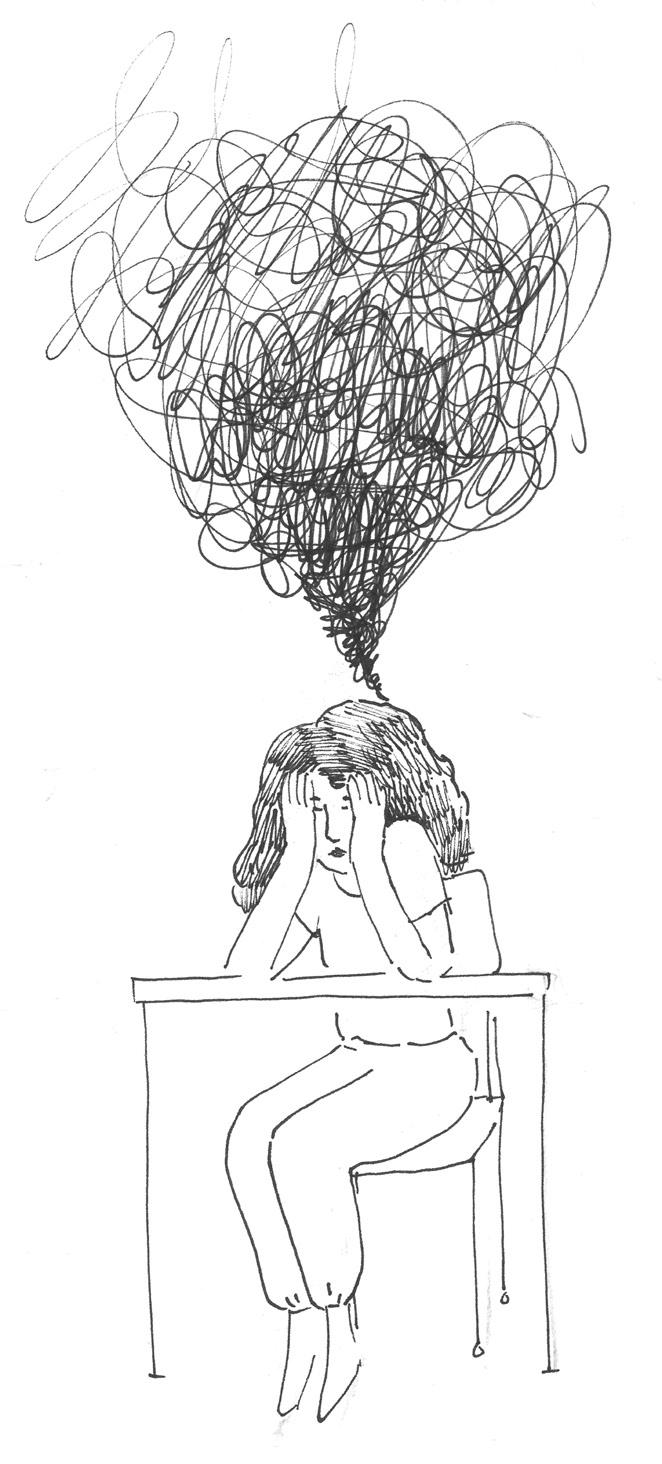
Emily Shuman (‘20) offers this piece of advice, “find out what you’re interested in and try to get into those classes instead of just taking the easy A classes.” This is huge. With any class you take at ORHS, you’re going to have to put in work. I have taken “easy A” classes that have caused me more stress than any higher level math or science class,
only because I had no interest in them.
Unfortunately, many students, myself included, feel pressure to take challenging classes their junior year. With our future ap plications in mind, many students opt for more rigorous courses, instead of taking the classes we would really enjoy.
Carly Anderson (‘21) described the pressure of taking diffi cult classes for colleges to see and to stand out against other ap plicants. “I felt without [challenging classes], that might put me in a place where I wasn’t as prepared as some other people and if schools see that, I might not be as eligible,” said Anderson.
I completely agree with Anderson. There is an enormous pressure to get good grades your junior year. As students, we are told by parents, teachers, and classmates that junior year is the most important year of high school, as that it was colleges look at the most. This idea was something I was aware of early on in high school, but failed to consider how true it was or the toll it would take on me.
ORHS school counselor, Jason Baker agreed that the pressure to do well is there but said, “the biggest challenge is that [the pressure] is built up. Whether it’s kids talking to other kids, kids talking to their parents, reading stuff on the internet, or just hearing things we say unintentionally.”
Lauren Hoppler (‘22) has already heard this idea. “There’s stigma that it’s the hardest year and that colleges look at your junior year so I feel that the pressure is definitey there.”
Anderson agreed saying, “I was also told that junior year is the hardest, but I did set myself up for a really hard year. There are ways to make it not as hard but I do think there was a large increase of stress.”
While junior year is important and it’s the first year many students begin to take more advanced classes, it’s not all or nothing. “If you have a bad quarter one or a first semester of junior year, your life is not ruined. Do your best. Bite off what you can chew. Do not bite off more than that. Just put in the best effort that you can and it will work out,” said Baker.
Baker explained how a high schooler at ORHS doesn’t necessarily need to have an overloaded schedule to be prepared for college or other future plans. “You could have a meaningful six period day that’s appropriately challenging but also gives you that period off where you don’t have to work. So, I encourage students to really con sider having a free period. You can easily have one and take appropriately challenging classes that set you up for a life after high school,” said Baker.
Baker explained that when you do have an overloaded schedule, you’re going to lose some thing in the process. “If it’s too big and there’s
too much to handle usually something gives. Maybe they keep that schedule all year but they might not get the grades they want. You only have so much attention you can give to classes and so much effort that you can give so if you’re at max capacity and you’re not making the progress you feel comfortable mak ing, something’s going to give,” said Baker. From my experience, this is one hundred percent accurate. While I kept my perhaps crazy schedule, the first thing to give was my grades.
Since middle school, I had gotten fairly good grades, ad mittedly without much studying. Junior year changed that for me and I found myself in a position I had never been in before,
ant. You may not think you have time in your day for self care, but you do. You have to. Because if you don’t, you’re go ing to burn out. Whatever it is, it goes back to being selfish, in a good way,” said Baker.
Another misconception that I had strongly believed is that junior year is a good time to get your credits in to give your self an easy senior year. However, Baker poses the question, “If you get all your credits done by junior year, what are you going to do senior year?” Unless you’re graduating early, col leges don’t want to see you slacking off your senior year, so it’s important to find a way to balance your required classes
where I had to build my work ethic from scratch. This happens to many students at some point, whether it’s the start of middle or high school, their freshman year of college, or, in my case, the dreaded junior year.
Shuman said that junior year she began to think about home work all the time, even during play rehearsal. “While sitting off stage you have to do homework, you have to be studying, you have to do Quizlet on your phone and be quizzing yourself in the car or on the bus or any time you can, because teachers do expect so much from you so you have to manage your time really well.”
Early on in the year, I began to rethink my entire schedule and found myself regretting the number of classes I had signed up for. I quickly discovered that my self made goal of getting straight A’s through my seven-period head ache of a schedule was next to impossible, at least for me.
Going along with that, Shuman ex plained, “sophomore year you don’t really get to pick what you do, you get assigned to most classes. If they are easy for you, you don’t real ly have any other options so you could easily get an A. Junior year you really get to start choosing what you want. The classes that you want might be hard, so you can’t go in expecting to get 95s on everything.”
Along with my grades, I also found that I had lost a lot of time for myself. With the new amount of work and expectations I found went hand in hand with junior year, I could no longer get away with going home and watching TV after school or spending time with my friends every weekend. This caused me to think about why I was taking seven rigorous courses and if the amount of stress I put on myself was worth it.
Baker explained that despite the amount of work you may have, you have to prioritize yourself. “Self care is super import
throughout your four years at Oyster River.
So, if you are an underclassman stressing about your junior year, I highly suggest planning out a schedule of classes for your four years of high school. This is helpful because it al lows you to make a plan and see an end goal. If you know you want to take a certain class senior year, this allows you to take the prerequisites now before you find it’s too late.
However, I don’t recommend making this your only plan. It is important to be flexible and to take the advice from family, friends, or teachers to heart when they tell you your course load may be too much to handle.
Baker said, “sometimes the path you’ve laid out for yourself or the one you feel that you should follow, sometimes you follow it and it works out and sometimes you take a different path but you can still get to where you want to go.”
When signing up for your junior year classes, I challenge you to ask yourself “why?” Determine why you’re taking the classes you’re taking and to make sure you’re taking them for the right reasons, meaning the classes that you’re actually interested in. Don’t take the easy A class only for that easy A, but also don’t pack your seven period day full of AP classes if you can’t handle that.
If there’s one thing I want you to take from this article, it’s something I wish I had heard before my junior year, which Baker said by asking the question, “what good are you to your academics, your friends, your parents, or to the people around you, what good are you to them, and what good are you to your self if you’re running on empty and stressed out?”

- Emily Hamilton
Artwork by Hannah Jeong
“You only have so much attention you can give to classes and so much effort that you can give so if you’re at max capacity and you’re not making the progress you feel com fortable making, something’s going to give.”

Matt Renner, Vice President of Production at National Geographic and Oyster River High School (ORHS) graduate (‘97) has filmed in the trenches on Deadliest Catch and was one of the producers for academy award winning film Free Solo. He explained the way to finding success is to, “put fear and everything aside into this little box and lock it away. Just go out and be daring.”
Renner, alongside his National Geographic team, won a to tal of seven Emmys and one Oscar for Free Solo, a film about a man, Alex Honnald who free soloed (rock climbed without ropes) El Capitan. These Emmys embody Renner's successful journey, which started back at ORHS. The support of the Durham community and the opportunities ORHS provided was the start to all of Renner’s success.
In high school, Renner participated in all kinds of opportu nities that ORHS offered. “I was a jack of all trades, master of none. I loved exposing myself to all different types of people and to different teachers. I was taught that you have one life to live and if you’re not participat ing and problem solv ing, then you are a part of the problem,” said Renner.
Amos Goss, an ORHS graduate (‘97) and longterm friend of Renner’s describes his personality in high school as, “super versatile. He was great at soccer but no jock. He was amazing in theatre but no theatre guy. Matt could hang with anyone; just a naturally curious guy.”
Coming out of high school, like most stu dents, Renner was still figuring himself out. Renner attended Colgate University where he played Division 1 soccer, how ever he still didn’t know what he wanted to do with his life. “I remember in college my advisor said to me, ‘You have to laso some courses together to have a concentration, just pick four. You could be a history major, an English major, a political science major, an economics major, just pick four or five’. How do you just pick four or five? How do people know what they want to be?” said Renner.
The summer after college, Renner was bartending in Bos ton when his dad forced him to get a “real job”. Renner always knew he would travel and see the world beyond Durham. In 2002, Goss who lived in Los Angeles, California asked Renner to live with him in LA. Renner saw this as his ticket out. Al though his parents were skeptical, Renner went to LA where he was opened to a world of opportunities. “I was teaching
improv classes and DJing at parties and working weddings, all to pay the bills […] this is when I had to put one foot in front of the other and started working for small TV companies where I found my love for storytelling,” Renner said.
While working on the set of these low budget TV shows called Boom and Live Like a Star, Renner was learning about the industry and meeting producers. As Renner said, “it’s all about the people you know.” A producer he had met along the way reached out and asked Renner to come with him to Alaska to film the show Deadliest Catch, which was about catfish ing on the Alaskan seas. Susie Renner, Matt’s mom, wasn’t surprised to hear a producer was interested in her son as she explained, “Matt has always been really good with people, he’s super easy to work with and he's a worker bee, he works really hard.”
Renner decided to move to Alaska to pursue Deadliest Catch. He recalled his experience on Deadliest Catch as, “life changing. There is nothing better than looking up at a sky that had colors of purples and blues and greens and oranges, skies that only 1% of the world could see.”
Although there were moments of beauty, being a cameraman on the boat was a dangerous job. Renner explained, “every one had to be everyone else's keeper. There would be many times when I was filming that some one would put their boot in my ass and kicked me forward as a 2,000lb crab pot fell right in my place. But there were other times where I would put my boot in their ass and kick them away from a line that was spinning overboard that would have drowned their ankle and taken them down. I had to always be on my toes.”
For seven years, Renner worked his way up on the set of Deadliest Catch. From production assistant, to the cameraman on the boat, to story producer, to series producer, and finally, to running the entire show. “It taught me how to be resilient and rely on myself… if [co-workers] were working, I was working. If they were sleeping, I was still working everyday showing my grit,” Renner said.
Renner’s nonstop work ethic and versatility made him unique. His unique personality not only showed on Deadliest Catch, but also back in high school. Dave Ervin, Renner’s mu sic teacher at both Oyster River Middle School (ORMS) and ORHS explained what made Renner different from his other students. “He had a crazy work ethic and it’s still that way
now. When you can find everything in life as being a really fun endeavor it’s not work anymore it’s something you can’t wait to do. Matt just loved life.”
A couple years after the end of the seventh season of Deadliest Catch, Renner received a phone call from a co-worker and friend of his that would be the start of his career at National Geo graphic. “I received a call from Tim Pastore who worked with me in the trenches on Deadliest Catch. He said, ‘I have a crazy idea. Why don’t you leave your job and come work for me at National Geograph ic and we together can re-imagine what National Geographic can be,’” said Renner.
Renner took the opportunity and turned National Geo graphic, which at the time was solely a magazine, into a film company with relevant and consistent NonFiction content. Content which included films such as, Hell on Earth, LA 92, Chain of Command and his most recent, Free Solo. “Every
cals and he was a class officer. You either take advantage of those things or you don’t, and Matt took advantage of them,” said Susie Renner.
Along with the op portunities Renner received, the support of the Durham community and teachers at ORHS has had a huge impact on his success. “I feel like I didn’t have one set of parents but seven or eight sets all looking out for me [...] this included teachers,” said Renner.
Agreeing with Renner, Goss explained how his friends success directly correlates with the high school teach ers he had. “So many of my friends have had such incredible success ranging from politics, athletics, music, entrepreneurship, but none more so than with Matt and his filmmaking. It’s really a credit to the Oyster Riv er teachers. So many teachers who had such a profound impact on Matt, myself, and so many others.”
One of the teachers Goss is referring to is Ervin and his relationship with Renner. “Mr. Ervin was a huge impact. He
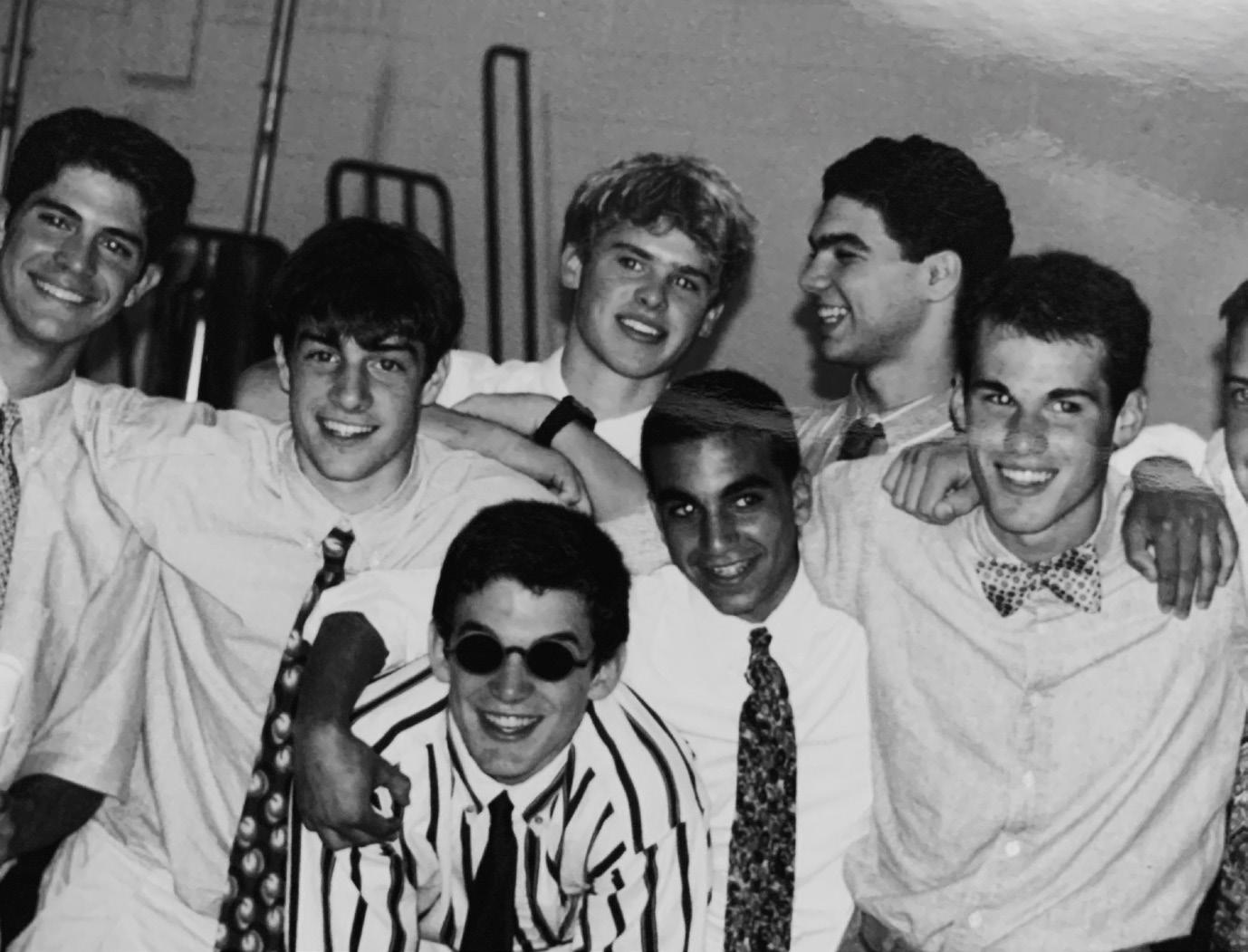
time Matt does something, I expect that something’s going to break or that it’ll be a huge success. He doesn’t do anything small,” said Goss in response to Renner’s success.
Through his work, Renner has made a name for himself throughout the production industry, and remains an impactful figure in the Durham community. “The more people you see from your community (Durham) become successful the more you realize ‘I can do this too’. It’s so inspiring to see somebody who was right here in these halls who now is doing something where you just think ‘wow that would be really cool to do’,” said Ervin.
As Renner has left his mark at ORHS and the community, growing up in Durham and attending ORHS has impacted Renner’s journey as well. “Oyster River certainly opened up a lot of opportunities for him. He had the chance to play soccer, write for Mouth of the River, be in the school plays and musi
introduced me to the world of acting, storytelling and playing a character way back in the sixth grade. He really brought me out of my shell,” said Renner. Ervin and Renner have re mained close friends and continue to support each other today.
Renner’s path to all his success began at ORHS, starting with the teachers who impacted him, to the support he re ceived from the community. Renner’s urge to be involved and actively participate in every opportunity ORHS gave him set him up for success. Susie Renner saw the way ORHS opened doors for her son and believes, from seeing Renner's success that, “...the more you put into it, the more you get out of it. The more you do in high school, the more confidence you will have when you get out into the world and get involved.”
- Carissa Miller Images by Susie Renner
“There would be many times when I was filming that someone would put their boot in my ass and kicked me forward as a 2,000lb crab pot fell right in my place. But there were other times where I would put my boot in their ass and kick them away from a line that was spinning overboard that would have drowned their ankle and taken them down.”
On the surface, days like Groutfit Tuesday and PJ Wednesday are just excuses for the senior class to wear ridiculous outfits. But to the students involved, it’s about uniting their class during their final year together.
The idea for Groutfit Tuesday began in October, when Dylon Thompson and Jacob Fradillada (‘20) adopted the term, which is a portmanteau of the words gray and outfit. For the next five weeks, a large portion of the senior class wore all gray as part of Groutfit Tuesday. Soon after, signs were posted on bulletin boards and social media spreading the message to wear all gray. The event was later changed to PJ Wednesday, which had a similar cult following. These
Mark at school wearing a full Groutfit, but it was completely unintentional,” said Fradillada. Hodge enjoys the joke, as it is in good spirit, and is proud to have worn the outfit that started it all.

“I felt honored as time went on, and people were making it special, from some thing I created,” said Hodge.
Inspired by Hodge’s unique style, Hodge, Fradillada, and Thompson began to organize the rest of their friend group to all wear Groutfits. Shortly after, when Thompson designed a poster to advertise the phenomenon in the Senior Core, participation grew swiftly. The largest Groutfit Tues day had roughly 35 recorded participants, and Thompson noted that many more may have participated, but did not sign their name on the “official” poster, posted in the senior core.
events were created to bring the senior class together, and for the students involved it has done exactly that.
Participation in Groutfit Tuesday and its associated events is not as high as other school events, but participants find great value in the event. “I felt like it was a really cool way to bring the senior class together, just something fun that we all did,” said Groutfit Tuesday and PJ Wednesday participant Signe Kula (‘20). The participants in Fradillada and Thompson’s days enjoy the camaraderie of wearing the outlandish outfits and often compare it to spirit week.
It is impossible to please everyone with a theme day. Some students are comfortable with one and not the other, and as a result, participation sees natural ebbs and flows.
“[I didn’t like] that I’d be wearing my PJs to school,” said Cole Golding (‘20). Golding was a repeat Groutfit Tuesday participant, and enjoyed the freedom of the day. “Groutfit Tuesday is just a gray outfit, it can be anything. I could wear gray khakis or something like that,” he said. Golding, like Kula, spoke highly of what the event brings to their class: unity. “It’s bringing people in the grade together,” Golding said, adding “it’s fun to see everyone’s ‘groutfits’.”
Thompson describes a Groutfit as “an outfit that is entirely gray, from head to toe. Hence the name, which means gray outfit.” The idea for a Groutfit wasn’t created on a whim, as the first-ever was worn by a friend of Fradil lada and Thompson, Mark Hodge. “I saw

Groutfit Tuesday was declared dead by Thompson during a speech in the Senior Core on November 12th, as a result of an Instagram poll where an overwhelming majori ty voted to start a new tradition. This led to PJ Wednesday, and the founders of Groutfit Tuesday have plans to keep things interesting in the future.
“People stopped wanting to wear gray outfits all the time, so we came to the conclusion that we would do something else fun. It’s fun for the class, and it’s a nice thing to bring us together,” said Thompson. Thompson added that further changes would likely occur on a monthly basis, and that he looks to continue the tradition for as long as possible.
While Groutfit Tuesday may be over, its essence still lives on with Thompson and Fradillada planning many more days for the senior class in the future. They both hope to continue this weekly tradition until the senior class inev itably has Cap & Gown Day on June 12th.
-Sean Moriarty
The self-proclaimed social movement & its associated events.
Sketch example of a typical PJ Wednesday outfit.
“It’s fun for the class, and it’s a nice thing to bring us together.”
“I saw Mark at school wearing a full Groutfit, but it was completely un intentional.”
“The biggest pressure that freshmen face when playing on varsity is living up to the expectations that have been set for them,” said Nicole Casimiro, the ORHS Girls Varsity Basketball Head Coach. Three years ago this was me: a 14 year old who was thrown into the world of varsity athletics.
Every year we see a handful of Oyster River High School students make varsity athletic teams as freshmen. This role is one that carries a lot of excitement and pressure. I myself have reaped the benefits of having this opportunity, but I have also experienced the immense pressure and added stress that comes along with this feat. I was interested to see how others’ experi ences compared to mine and whether they felt similar pressures as freshman on varsity.

To most people, these athletes arrive out of the blue as freshmen with immense talent in their particular sport. In reality, there is a long pipeline of anticipation that these athletes experience. This pipeline starts for most in early middle school when teams become more competitive and a talent divide begins to appear. Athletes who begin to distinguish themselves from their peers start to receive attention from coaches and begin the daunting preparation for the high school level. For me, my coaches started talking to me about the possibilities of high school sports around the sixth grade.
I can recall being in middle school and feeling the reality of high school athletics quickly approaching. It was drilled into my head how much of a change high school basketball was going to be. When freshman year finally rolled around there was a lot of pressure to be on that team. Even when I made the team, I had to live up to the expectation that everyone around me had. I also experienced added social pressures that I didn’t anticipate: the pressure of playing with guys who were three and four years older than me. However, the biggest pressure that I faced didn’t come from my parents, coaches, or teammates. The largest expectations and pressure came from myself.
This fall, ORHS saw a freshman, Emma Hampton, play a crucial role on the volleyball team. “In the beginning I felt like I had to prove that I belonged. I was scared of messing up. I wasn’t sure if I would be able to live up to the expectations that my coach, and everyone else had for me,” she said.
When a freshman takes the court, field, ice, or track for the first time there’s a wave of emotions. The first time I was thrown into the game I was terrified. My stomach filled with nerves as I waited at the scorer’s table to check in. Once I hit the court, it all went away. I was ready to prove to everyone, includ ing myself, that I deserved to be there.
Charlotte Cousins (‘22), experienced a similar feeling with her first game. “I remember my first game was against our rival Coe Brown, and I just wanted to prove to everyone on the team that they could trust me,” she said.
The pressure that many athletes face as freshman can also be a significant motivator. “I felt like I really needed to prove my spot on the team and show everyone that I do deserve to be on the team in that kind of made me work harder,” said Corinne Quaglieri (‘20).
Over the course of the season, these athletes learn and grow in many ways. Often these freshmen are welcomed by a rude awakening of maturity and higher standards. “I have played with and watched players who start to develop a sense of self as they get older. For the most part, [athletes] will come in timid so as not to step on anyone’s toes,” said Casimiro about athletes’ growth freshman year. She added that, “once they feel comfort able they are able to truly show what made them a valuable asset to the team. The best part of having a freshman on varsity is watching their game mature and when they start to gain confi dence at that level.”
All freshmen have a point in their season when they become more comfortable with themselves and their new surroundings. “As I became more confident with myself and started to find success, my teammates were completely supportive of me. They were always there for me and treated me like everyone else,” said Hampton.
Teammates are often times the most crucial support network when a freshman is on varsity. However, in some instances it can also be the downfall of a freshman’s confidence when spiteful or jealous behavior is exhibited by the upperclassmen on the team. This negative behavior was one that I was fearful of when I first started playing on varsity. I was grateful that throughout my en tire freshman season I had supportive teammates. The positivity and motivation that my teammates had toward me, allowed me to become more confident and find success on that team. “I think there’s this stigma that the seniors are gonna harass freshmen, but that wasn’t the case for me,” said Cousins. She added that, “everyone on the team my freshman year was always super nice to me, and treated me by the way I played.”
For Hampton, Quaglieri was the senior captain on the team and was able to connect with her. “I kind of understood what [Hampton] felt like because I was in her position just three years ago,” said Quaglieri. She added that she, “tried to talk to her at practices just to make her feel welcome and included because I know that it’s really intimidating having older girls on the team, at least it was for me. We tried to make that transition as smooth as possible.”
Casimiro noted that for freshman to be successful they must, “be confident yet humble, continue to work on your game and take advice.” She concluded by saying that the, “players with intrinsic motivation and an eye for the game and learning will be successful as freshman on varsity.”


Great Bay CrossFit’s High School Strength and Conditioning program is the perfect solution for preparing yourself mentally and physically for your sport. With our customized programming and attention to detail, you will be making progress with every workout, while staying injury free. Email us for more information: info@greatbaycrossfit.com



